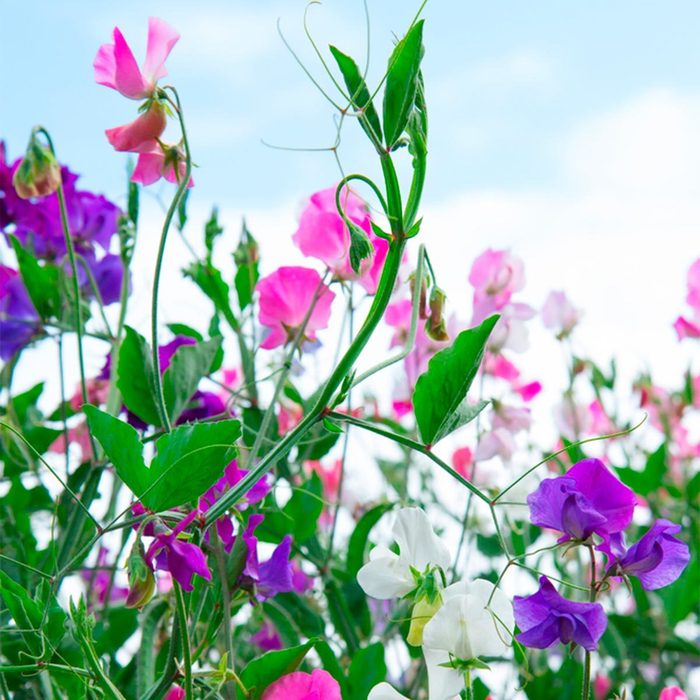
Sweat Pea
As the name suggests, sweet pea is sweetly fragrant when blooming in spring. It’s also quite ornamental, thanks to the brightly hued pastel flowers of pink, purple and white. Give it something to ramble on and put it where you can enjoy the scent—by a garden gate or doorway, for instance. Sweet pea (Lathrys odoratus) is an annual vine growing about three feet tall.
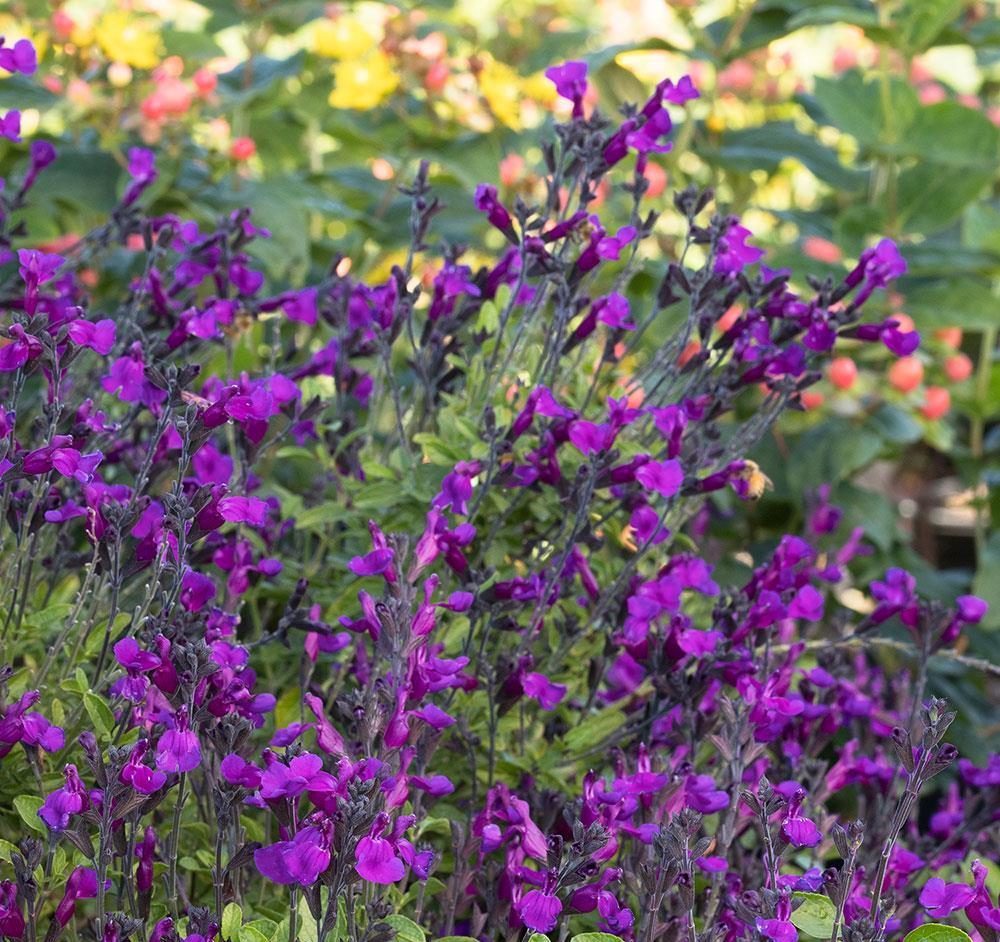
VIBE “Ignition Purple”
VIBE “Ignition Purple” is a Salvia and jamensis hybrid with both beauty and brawn. The vibrant purple blooms are prolific in spring and summer, but it also has excellent heat and humidity tolerance. “Ignition Purple” grows 18-24 in. tall and wide and is perfect for flower borders, cutting gardens and wildlife plantings. It is hardy in Zones 7-11.
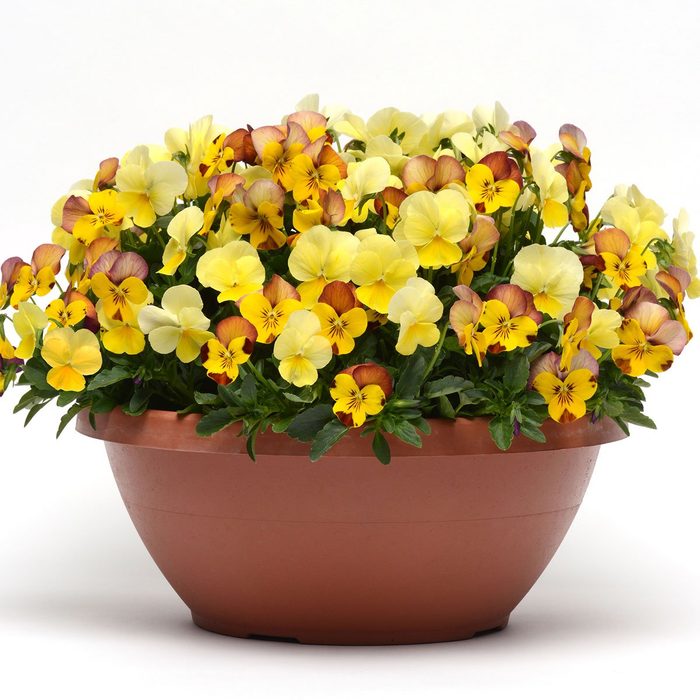
Viola
Although usually grown as an annual, violas are frost-tolerant and many overwinter successfully. Their compact size and free-flowering habit are a good fit for container gardening. There are a range of bright, festive colours, including white, lilac, purple, yellow and orange. This mix of lemon and peach colours is called Sunset Boulevard. Violas are available at your favourite local garden retailer.
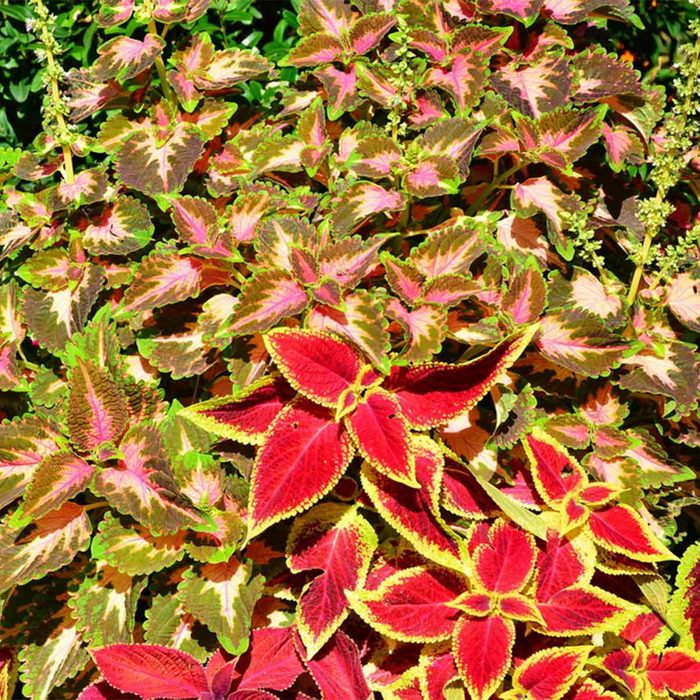
Coleus
Coleus (Solenostemon scutellariodes) isn’t just about variegation and it isn’t just about colour. It’s about BOTH. The foliage has almost as many variegation patterns as it does colour choices, and there are more named varieties introduced every year. Colours range from hues of green and yellow to red, pink, purple, bronze and orange—some solid, some variegated in beautiful patterns. These popular annual plants with colourful leaves typically grow 10 to 15 inches tall and also feature summer flowers.
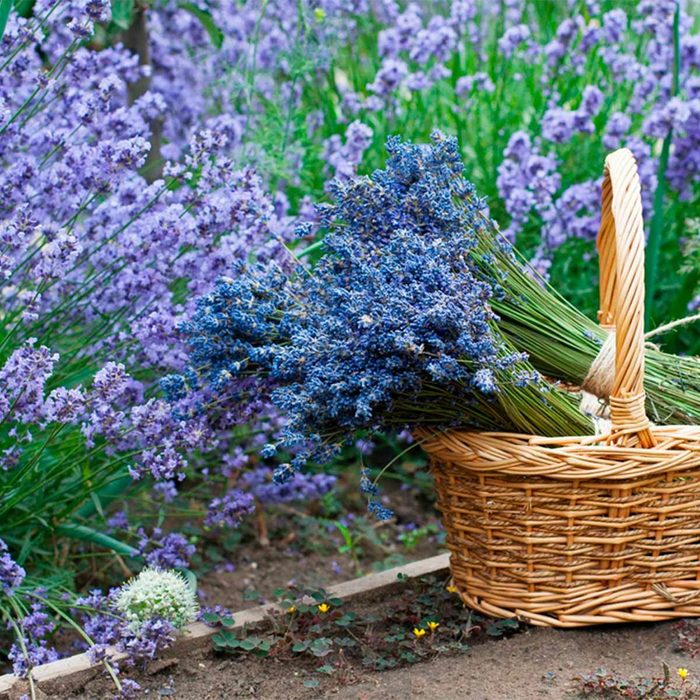
Lavender
Lavender is one of the most colourful—and fragrant—herbs. The flowers dry nicely and are often put in potpourri or bundled in sachets and kept in a sock drawer. The plants with colourful leaves are also good at repelling mosquitos and flies in the garden. Lavender (Lavandula spp.) is easy to grow if the site is sunny and has well-drained, slightly alkaline soil. Most are hardy in Zones 5 or 6-9, depending on species.
Find out more of the best mosquito repellent plants worth adding to your landscaping.
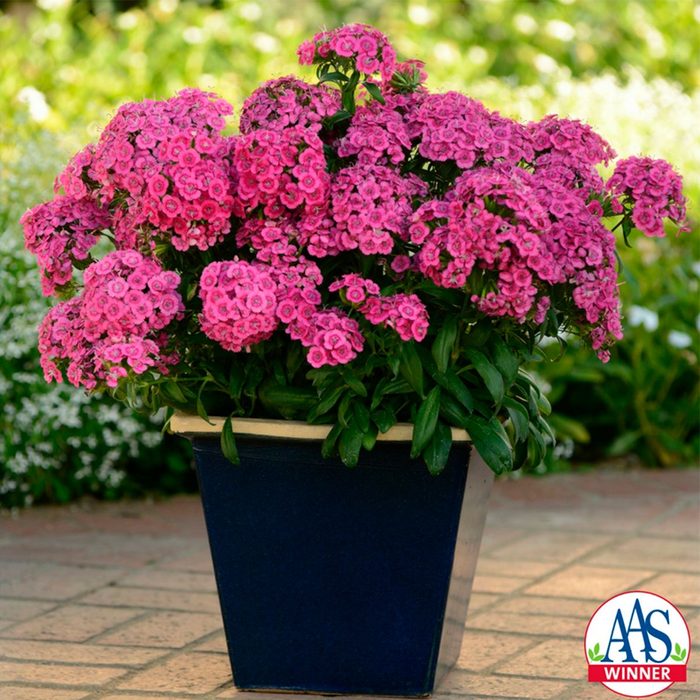
Jolt Pink Dianthus
This dianthus features large, brightly coloured fringed flower heads on strong stems. Dianthus typically prefers cooler spring temperatures, but Jolt Pink is heat-tolerant so it should perform well all summer long to make for beautiful yard flowers. It’s an easy-to-grow flower for those who like their container gardening neat and tidy. Jolt Pink is hardy from Zones 7-10, or grow it as an annual.
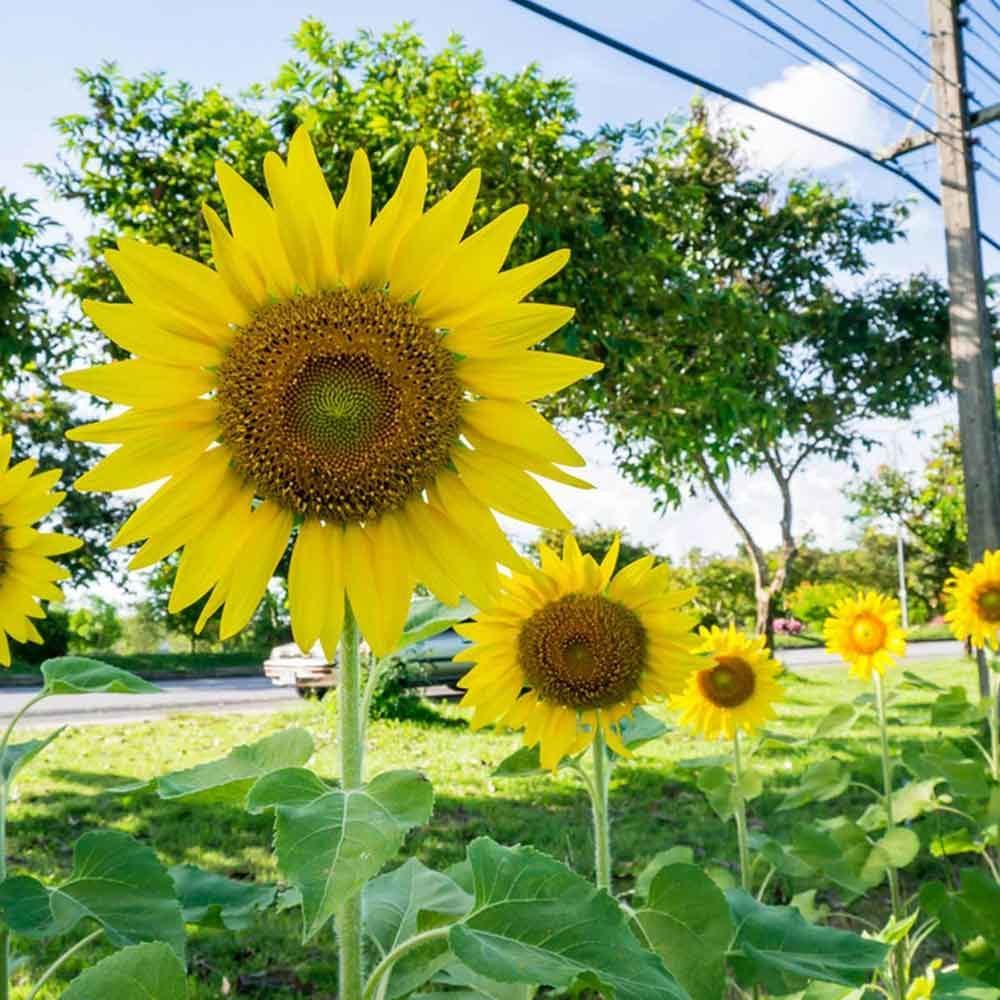
Sunflower
Some varieties of sunflowers grow to up to 10 ft. tall! Choose one that stays a reasonable height and you’ll enjoy showy flowers and tasty seeds.
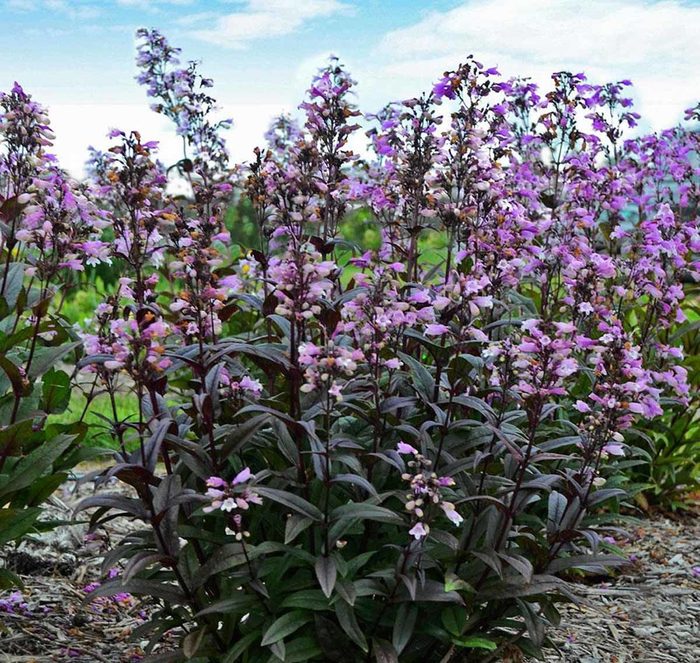
Blackbeard Penstemon
This heat-, humidity- and cold-tolerant perennial is great at attracting hummingbirds. “Blackbeard” boasts white-accented lilac flowers rising above dark-purple, mounded foliage. It grows 28-34 in. tall and two ft. wide and blooms from early to midsummer and are great garden plants and flowers. Burgundy seedpods follow, extending the season of interest. “Blackbeard” is hardy in Zones 3-8.
Here are eight more flowers that attract hummingbirds.
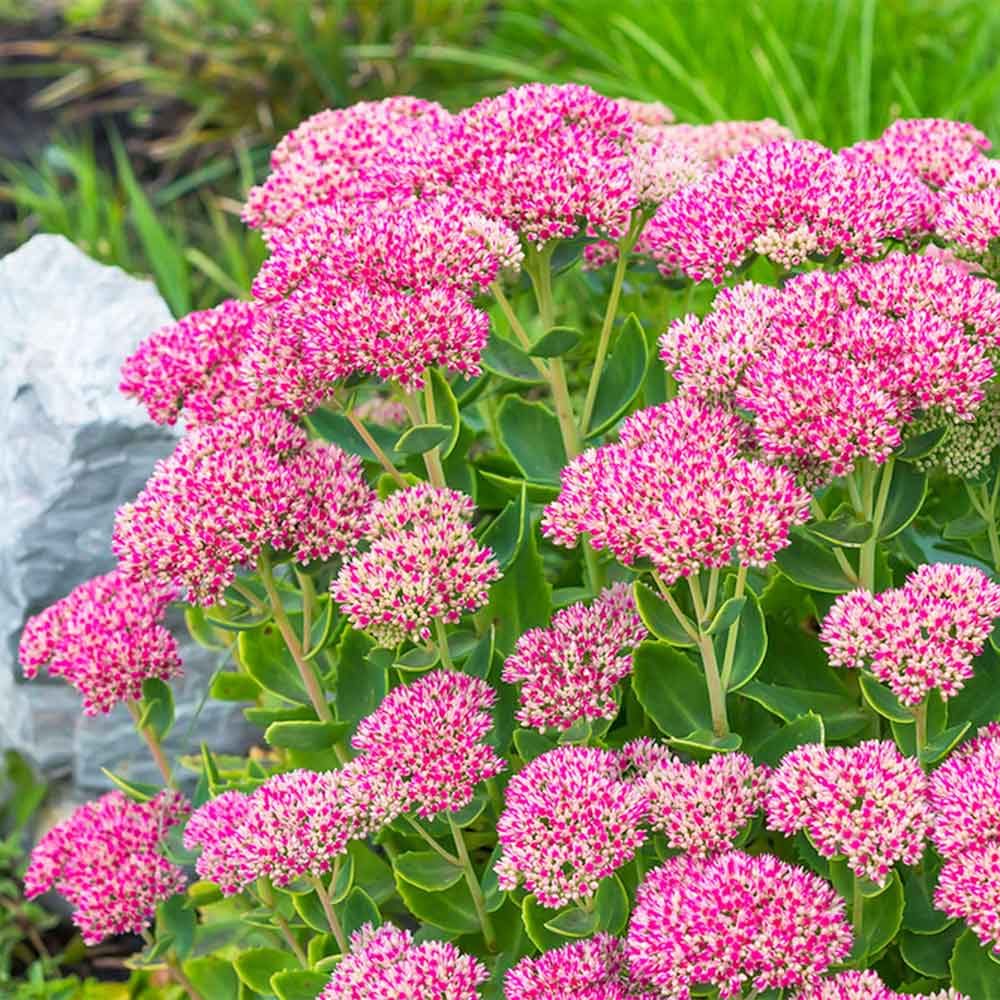
Sedum
If you want some great flower bed plants, look at sedum. For a swath of rich colour in a flowerbed, nothing works quite like sedum—and it’s a very common target for bees looking for a rich source of pollen. Plant seeds well apart and give them space to grow together over time.
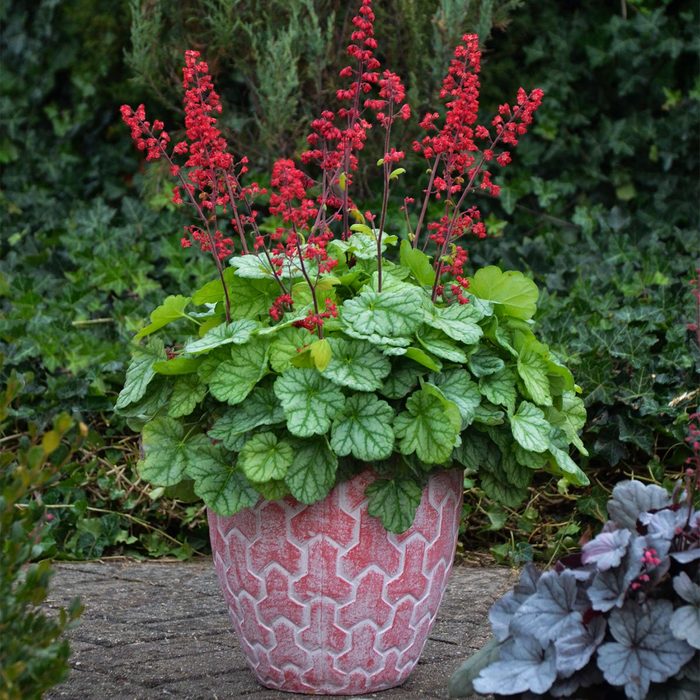
‘Pretty Pistachio’ and ‘Appletini’ Coralbells
Primo “Pretty Pistachio” and Dolce “Appletini” (shown here) may be coralbells (Heuchera spp.), but they have enough pizzazz to hold interest by themselves, making them one of the best plants for container gardening. ‘Pretty Pistachio’ features medium-pink flowers rising above mounded chartreuse foliage all summer long. “Appletini” offers ruby-red flowers on dark-red stems from early to midsummer. Its light-green foliage is decorated with an intriguing silver overlay for added appeal. Both perennials are hardy in Zones 4-9, preferring part shade but accepting full shade.
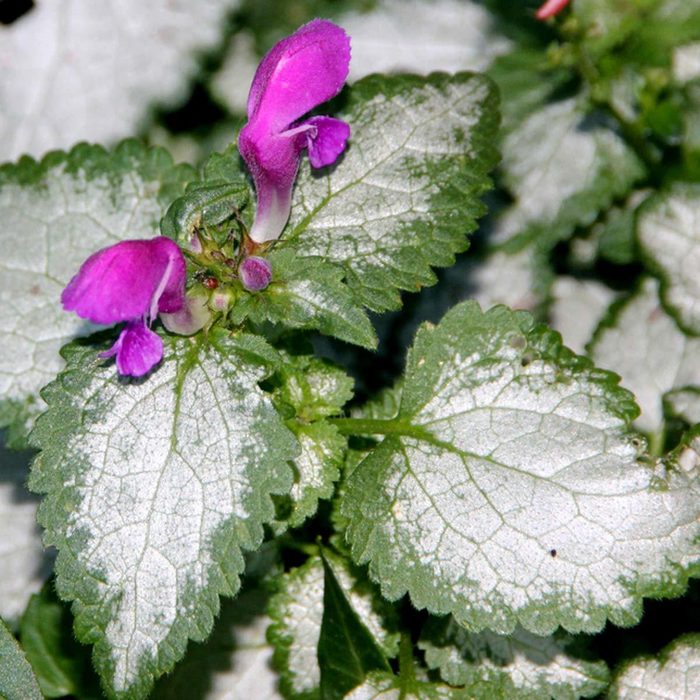
Lamium
Lamium (Lamium maculatum) is an easy-going groundcover beloved for its two-tone leaves and small yet colourful flowers in spring. Sometimes called spotted nettle, it features tiny snapdragon-like flowers in pink, purple or white. The flowers are a bonus, though. It’s the foliage that shines all season long with a number of different variegation patterns and colourful hues. Lamium is hardy in Zones 3 to 8, depending on cultivar and is among great landscaping bushes.
Keep your green thumb supple all winter long with these inspired indoor gardening ideas.
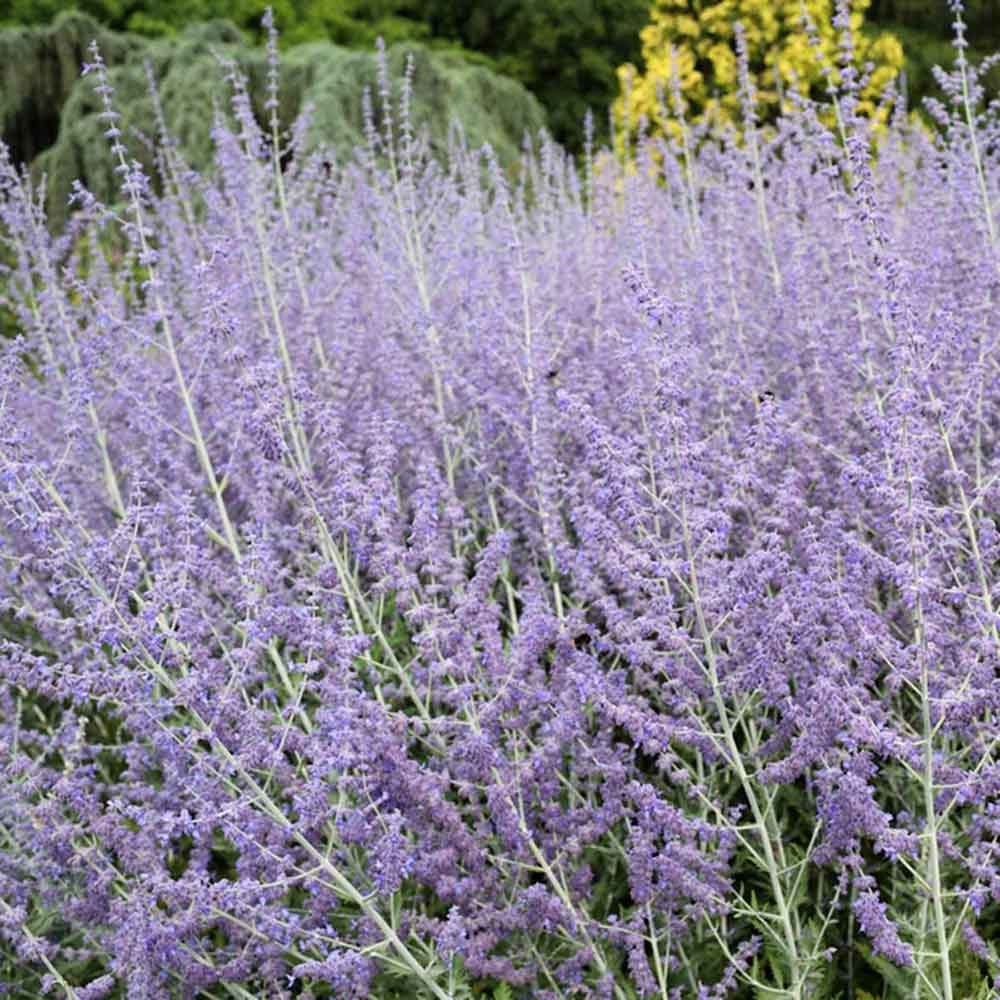
Russian Sage
This sun-loving, drought-tolerant perennial has a lovely fragrance. In the spring, cut back last year’s growth after new growth has started. This plant won’t take over your yard, either!
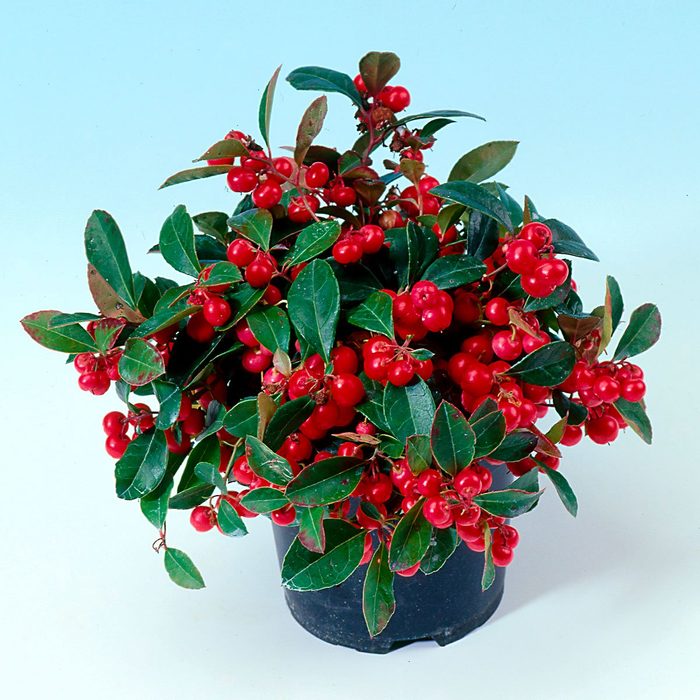
Very Berry Creeping Wintergreen
Very Berry creeping wintergreen (Gaultheria procumbens) is a tender perennial that’s hardy in Zones 6-9 but can be grown as an annual elsewhere. Very Berry offers glossy, dark leaves—the perfect backdrop for small, white, bell-shaped flowers in summer and bright-red, aromatic berries in early fall. The foliage later turns purplish, adding another bit of visual interest, so it’s great for container gardening.
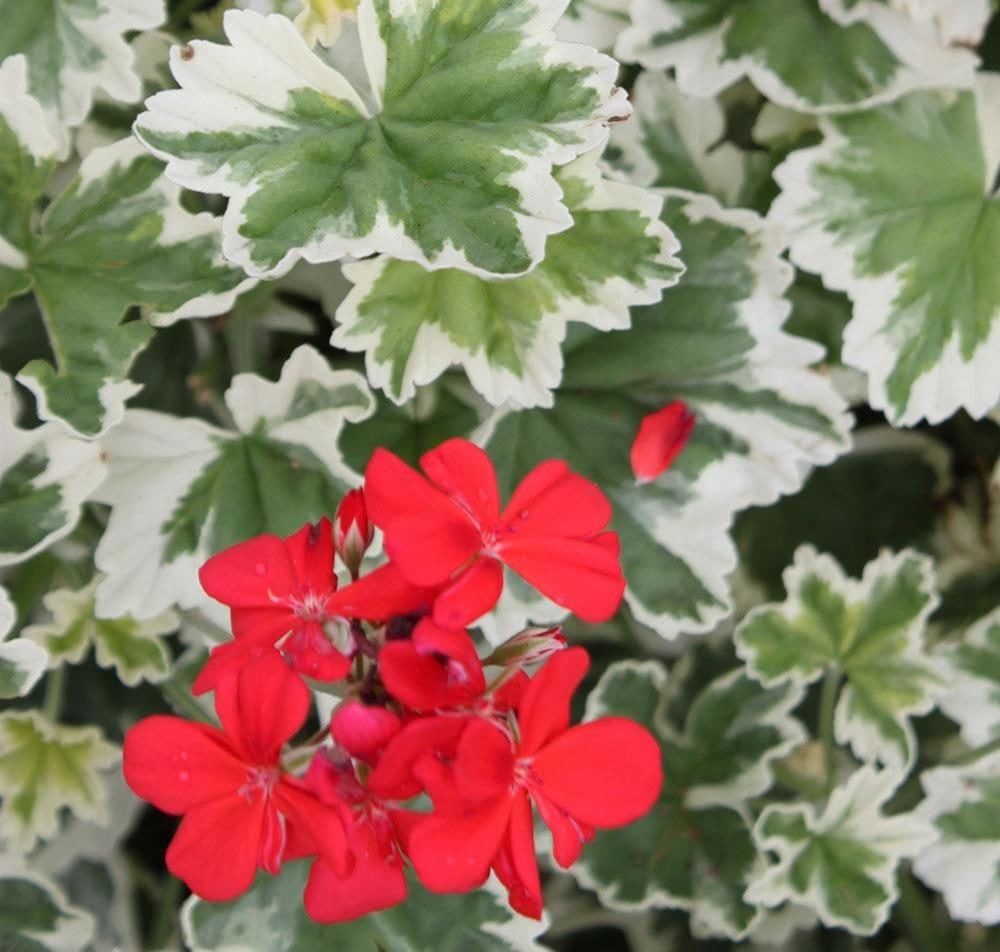
Mint Julep Annual Geranium
Mint Julep could almost make you forget about flowers. Almost. Just look at the beautiful variegated foliage with broad swatches of white along the borders—that alone is reason enough to grow this geranium. By all means, enjoy the scarlet-red flower clusters throughout the summer. But when the time comes to deadhead your geraniums, despair not. You’ve still got the foliage. Mint Julep grows one ft. tall and wide and are great flower bed plants.
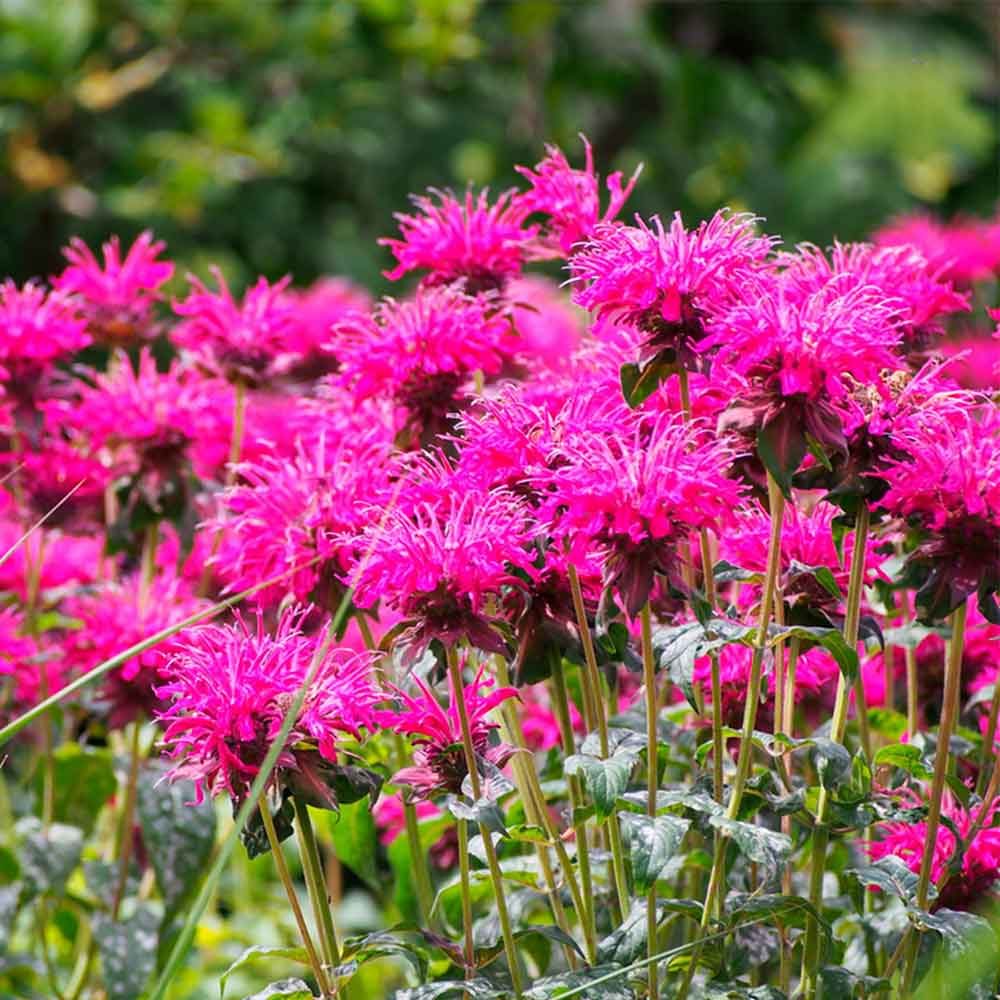
Bee Balm, Monarda
As the name implies, bees love the bee balm plant, and this spiky flower can provide an exotic flavour to your yard. Unlike many of the garden plants and flowers on our list, the bee balm doesn’t mind wet soil and marshy ground, making it more flexible when it comes to planting in clay or tougher soils.
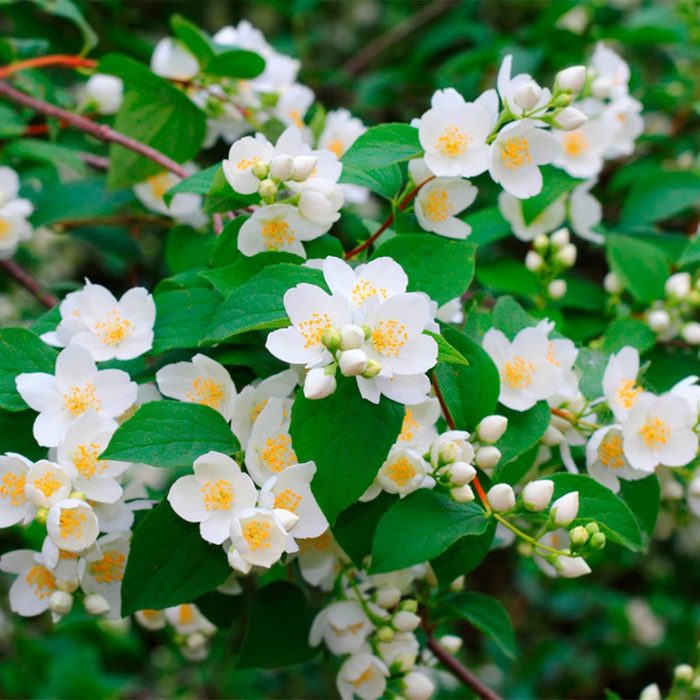
Mock Orange
Mock orange (Philadelphus spp.) will captivate you two ways: with its clear-white flowers with yellow centres, as well as its sweet perfume, cast in late spring when you’re out and about in the garden and can enjoy it. It’s one of the more striking landscaping bushes when in bloom, and a good background plant of 6-8 feet in height the rest of the season. It’s hardy in Zones 4-7.
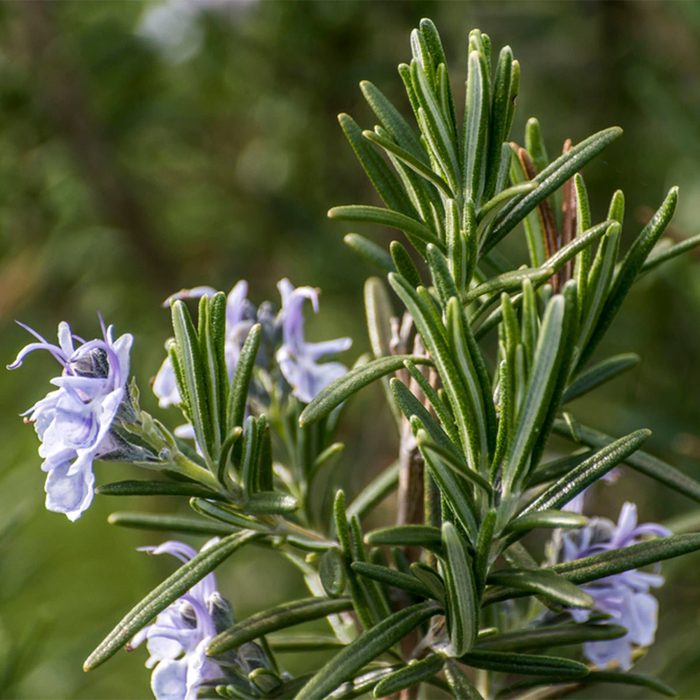
Rosemary
One touch of rosemary and you’ll be in seventh heaven because it’s one of the best landscaping plants. Run the palm of your hand over the evergreen-like foliage and then hold your hand up to your nose. You might not want to wash after that—the fragrance is that good! Rosemary (Rosmarinus spp.) is an evergreen shrub in Zones 8 and above, a tender annual herb in colder areas. You can grow it in a pot and bring it indoors for the winter if you have a bright southwest-facing window.
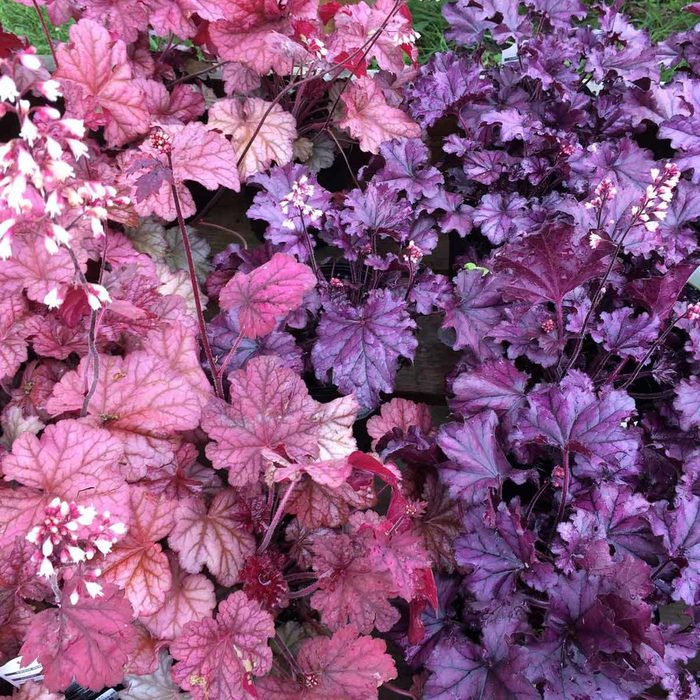
Coralbells
Coralbells (Heuchera) are becoming the foliage queens of the shade garden and landscaping bushes, thanks to ever-more-colourful cultivars hitting the market. This mixture of “Berry Smoothie” and “Forever Purple” coralbells makes a dynamic combination in the low-care shade garden. Like other coralbells, they also feature tiny bell-shape blooms in summer. Coralbells are hardy in Zones 4 to 9, depending on cultivar.
Get the biggest bang for your buck with these high-impact yet inexpensive plants.
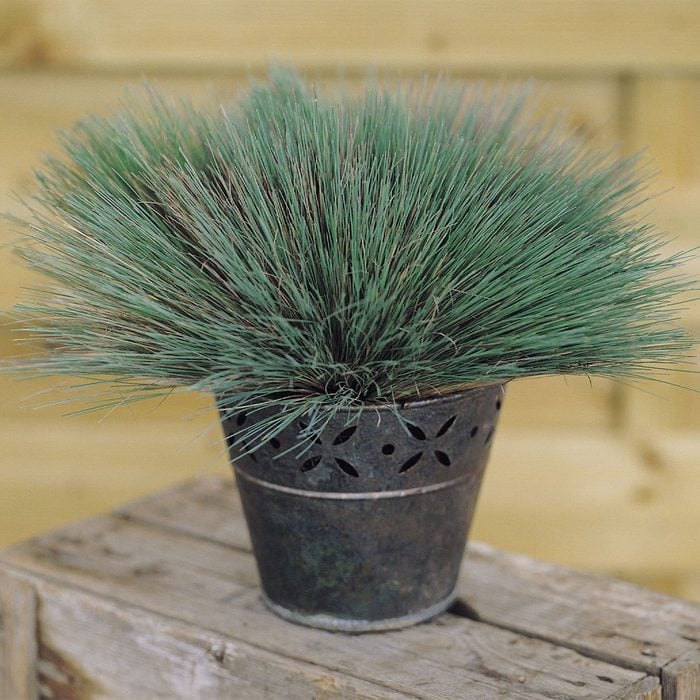
ColorGrass Spiky Blue Corynephorus
This upright perennial grass reaches about one ft. tall and eight in. wide, so it’s a natural as a groundcover or front-of-border plant. But the blue-grey spiky foliage is pretty enough to hold a container garden. Better yet, ColorGrass Spiky Blue is heat- and drought-tolerant, so it will hold up with minimal maintenance as landscaping bushes. Hardy in Zones 6-9, it can be treated as an annual in other areas.
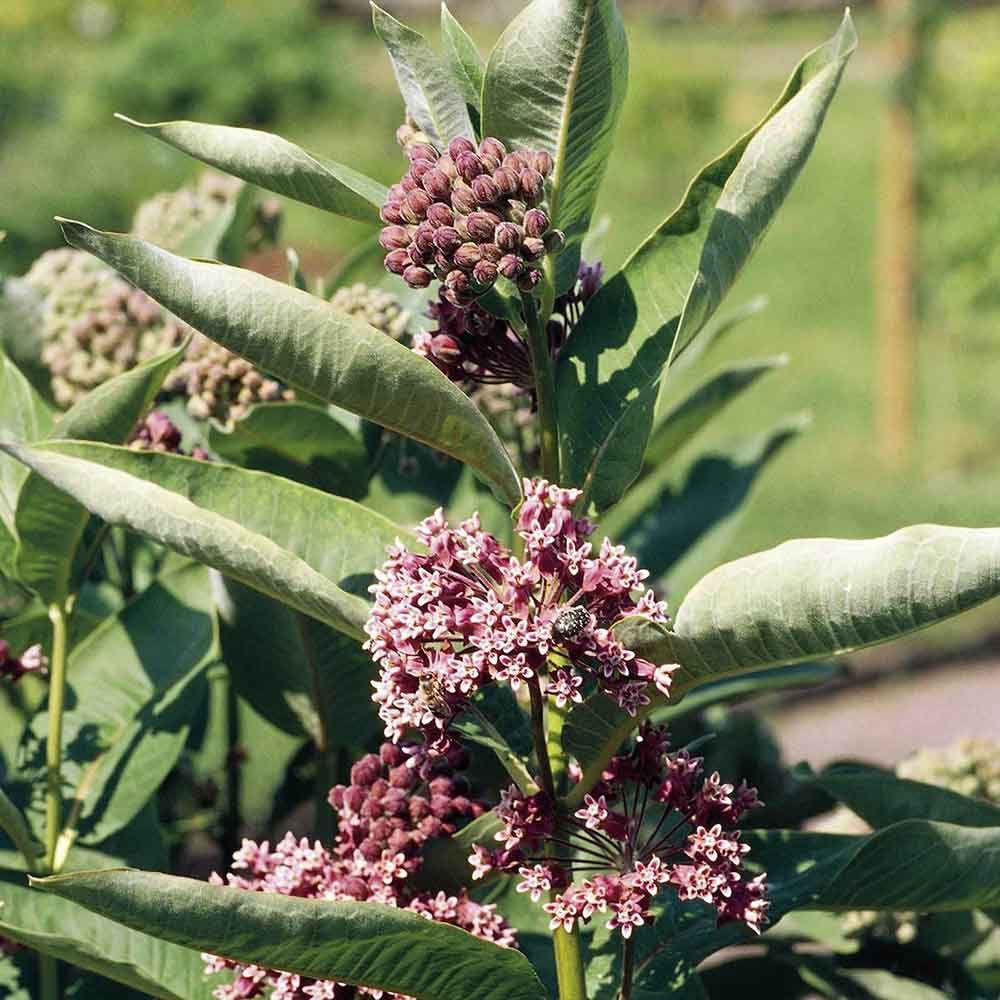
Milkweed
Don’t let the “weed” in milkweed bother you! Milkweed is a full-sun, drought-tolerant perennial, also known as Butterfly Plant. It’s one of the best landscape plant ideas for a number of reasons. Milkweed attracts Monarch butterflies, which is another reason to plant it in your boulevard garden. It’s also a good idea to grow bee-friendly plants.
Here are more tips for attracting butterflies to your backyard.
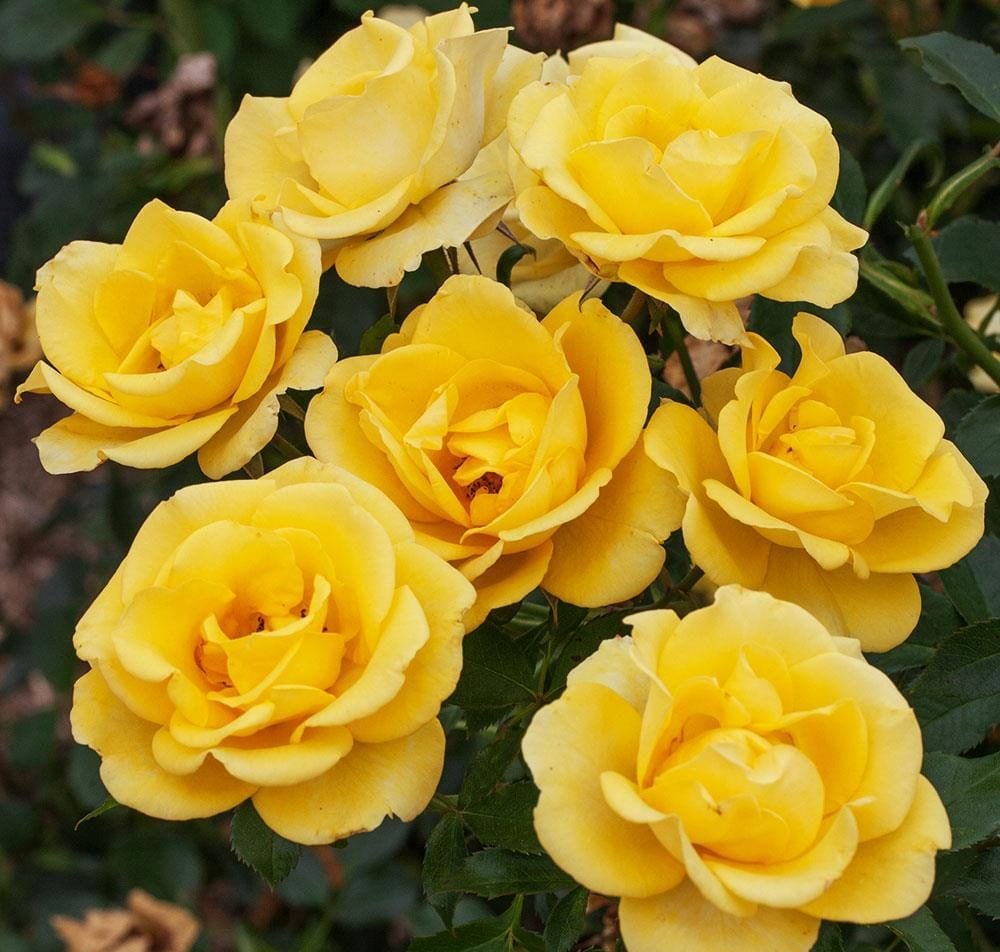
Gilded Sun Floribunda Rose
Yellow roses tend to bleach out in sunlight, losing their vivid colour. If you’re looking for plants with colourful leaves, then look at Gilded Sun. Gilded Sun is a new introduction with non-fading yellow blooms atop large, glossy green leaves. Some older roses have problems with diseases such as black-spot, but Gilded Sun is exceptionally disease resistant. Gilded Sun has an upright, bushy form, reaching 4-5 ft. in height, 3-4 ft. in width. It is hardy in Zones 5-9.
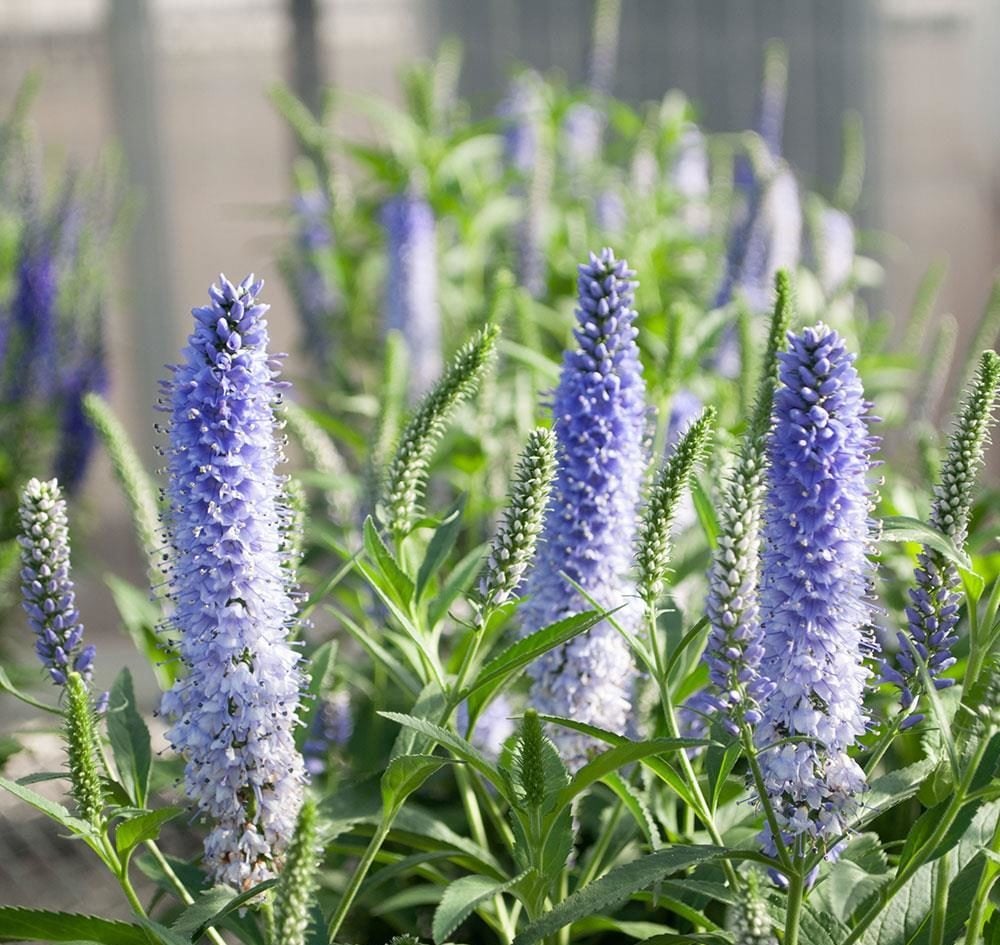
Vernique Shining Seas Veronica
Vernique Shining Seas joins its sibling, Vernique Blue, as stellar outdoor plants worthy of any cottage-style garden and great landscaping bushes. While the latter has rich purple flowers in summer, Shining Seas (shown) offers bicolour spikes of lavender-blue flowers. Both grow 18 in. tall and 16 in. wide and are hardy in Zones 4-8. Like other veronicas, Shining Seas and Blue are deer- and rabbit-resistant, making them brilliant landscape plant ideas.
New to nurseries and landscaping? Here’s what you should know before starting a garden.
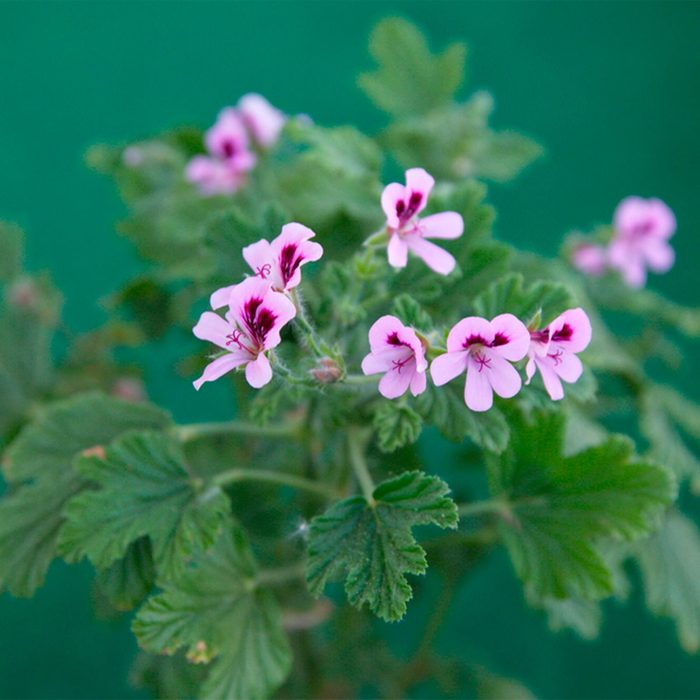
Scented Geraniums
Scented geraniums (Pelargonium spp.) are a delightful plant to have around the garden, even when they’re not blooming. The ornamental leaves have a wonderful fragrance to make it one of the great landscape plant ideas. Depending on species, scents include rose, peppermint, pine, lemon, and apple-nutmeg. They can be grown like common geraniums—plenty of sun and a well-drained soil—and treated as annuals.
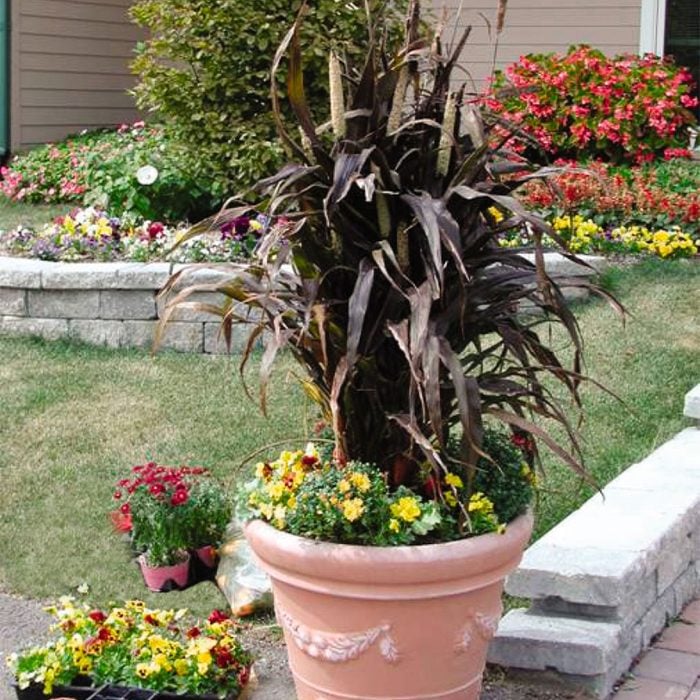
Purple Majesty Ornamental Millet
Here’s a plant with real stage presence when it comes to container gardening. Use it by itself or to back up smaller companions—just be sure to put it in a large pot. Purple Majesty ornamental millet (Pennisetum glaucum) grows four to five ft. tall and eight-12 in. wide. Its attractive foliage takes on a darker hue of purple in full sun to make it among the best flower landscape ideas. Purple Majesty is heat-tolerant and low-maintenance, and it offers interest from spring till early fall. In some climates, it holds on long enough to add winter interest as well.
Can’t decide what to grow in your planter pots? We’ve rounded up the best annuals for containers.
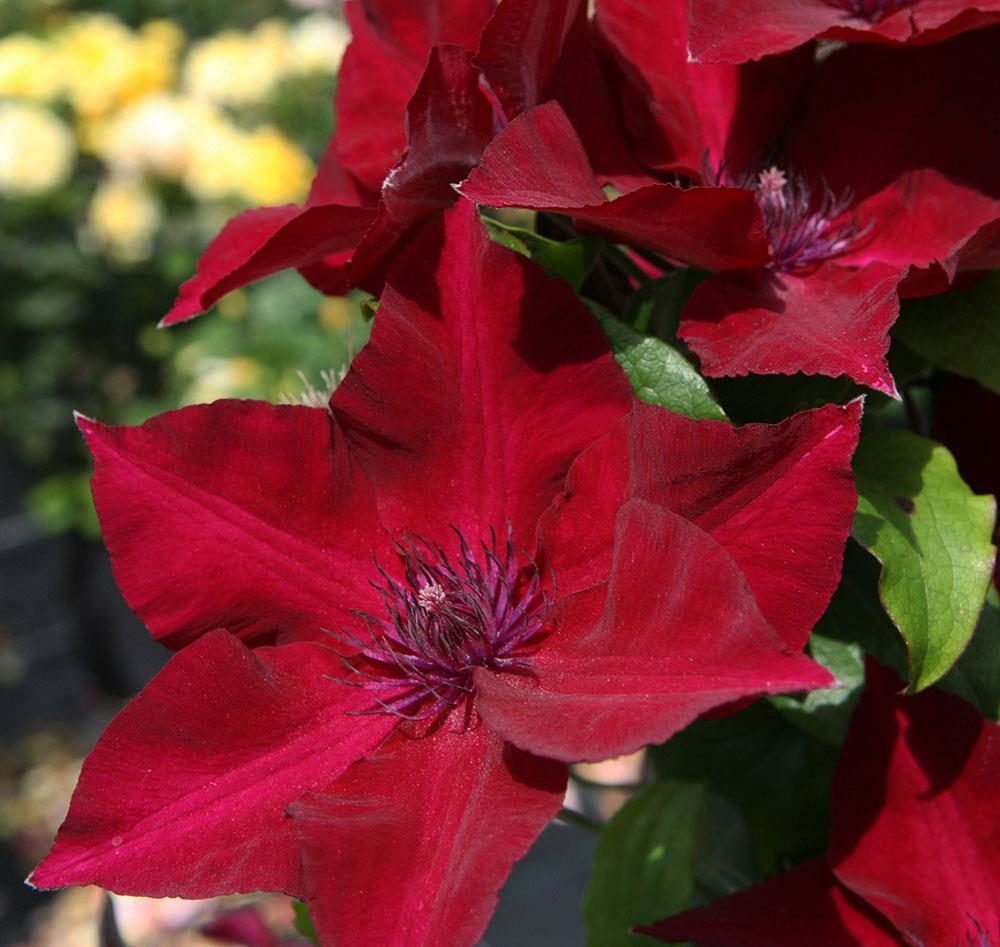
Nubia Clematis
The Boulevard series of clematis earn their stripes for a very simple reason: they have more blooms and a longer season of colour as well among garden flower plants. Boulevard flowers up and down the entire vine, not just at the top. Nubia is a new introduction with dark red blooms. It grows four to six ft. tall and blooms in spring and summer. Like other clematis, Nubia is best enjoyed when it has something to climb on. It is hardy from Zones 4-9.
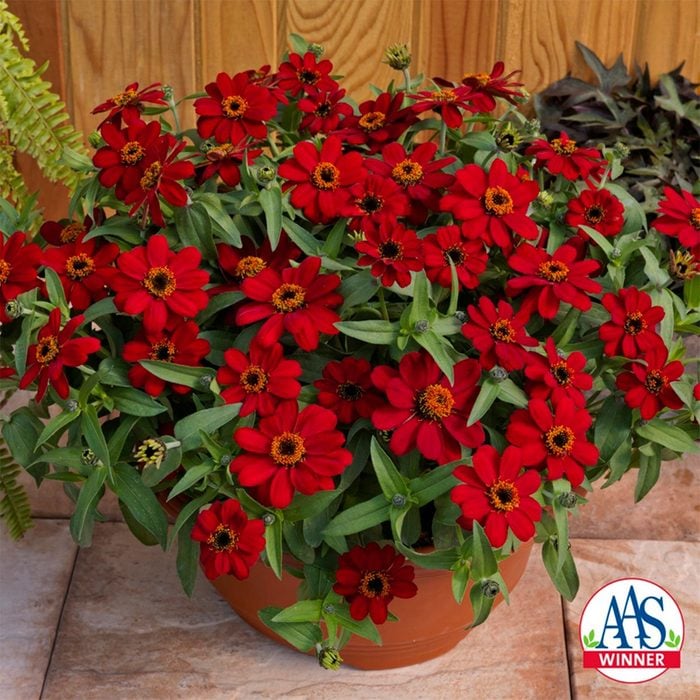
Profusion Red Zinnia
Profusion zinnias are beloved for their compact size, disease resistance, and lasting blooms among garden flower plants. This newest addition to the series offers the same features but with a true red colour that won’t fade in summer sunlight. A 2017 All-America Selections Winner, Profusion Red is the fourth colour in the single flower series to win the coveted AAS Winner award. It looks great in borders and in container gardening.
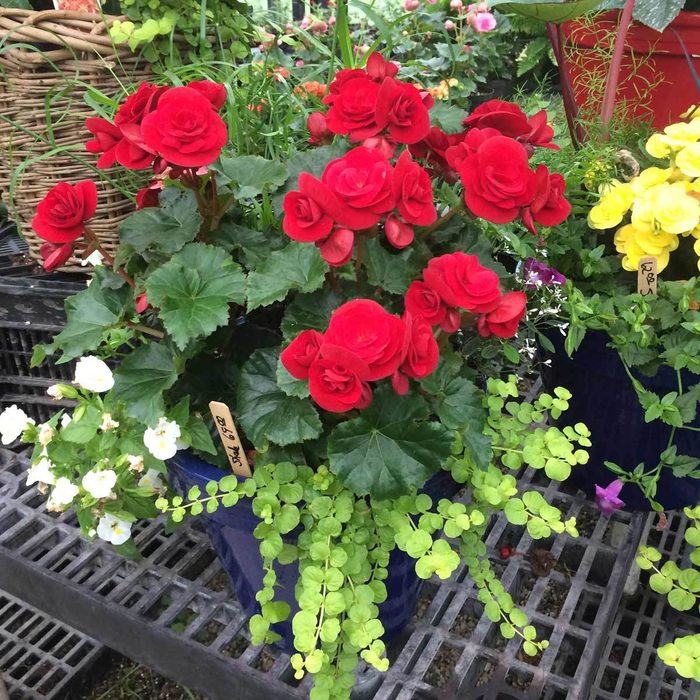
Begonia
Begonias are a treat to grow—mostly because they’re so colourful, but also because they take more shade than most annual garden plants and flowers. The tuberous begonias shown here are a good example. They’re paired with creeping Jenny (Lysimachia), a perennial groundcover with nicely contrasting chartreuse foliage. Both like evenly moist soils and light shade during the summer.
Ready to upgrade your garden? Follow these simple landscaping ideas.
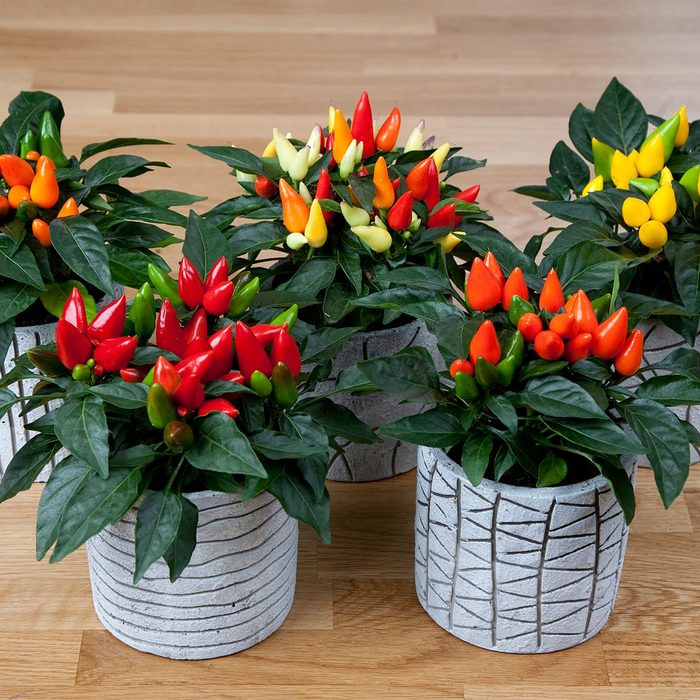
Ornamental Peppers
These heat-loving summer annuals are full of bright, cheerful fruit to rival the showstopping power of flowers. Colours of the Salsa Mix (shown) include red, orange and yellow, but some ornamental peppers have purplish foliage and fruits. The compact size and nicely branched habit of ornamental peppers make them a natural for container gardening. They’ll have the most fruit in full sun but will take part shade. Plants and seeds are available at your favourite local garden retailer.
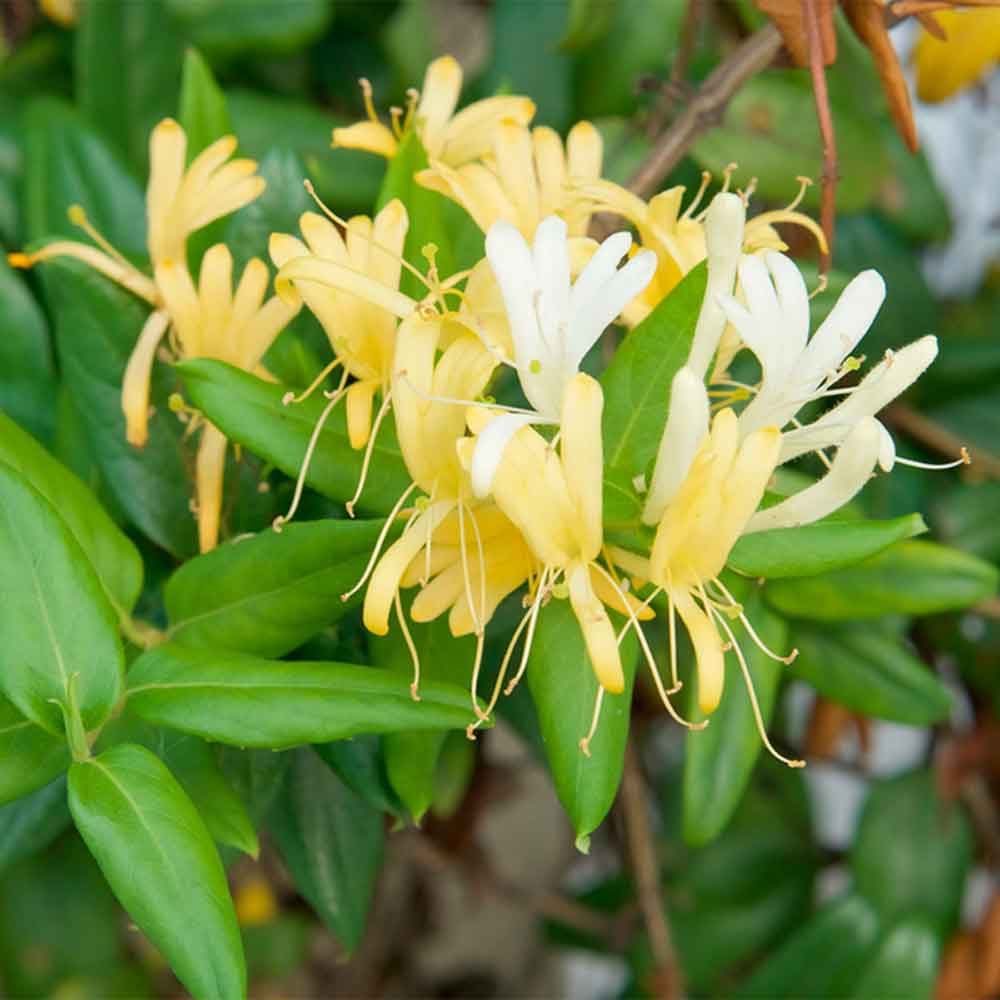
Honeysuckle
Honeysuckle needs no introduction: Famed for its scent and orchid-like flowers, honeysuckle is an amazing addition to any garden among garden flower plants. They come in bush or climber form based on the variety, which gives you a lot of options for placement (growing them around patios or decks is common for the fragrance). Like lilacs, honeysuckles can grow surprisingly large after a couple of years, so take note of space.
For more expert landscaping tips, check out these genius gardening hacks.
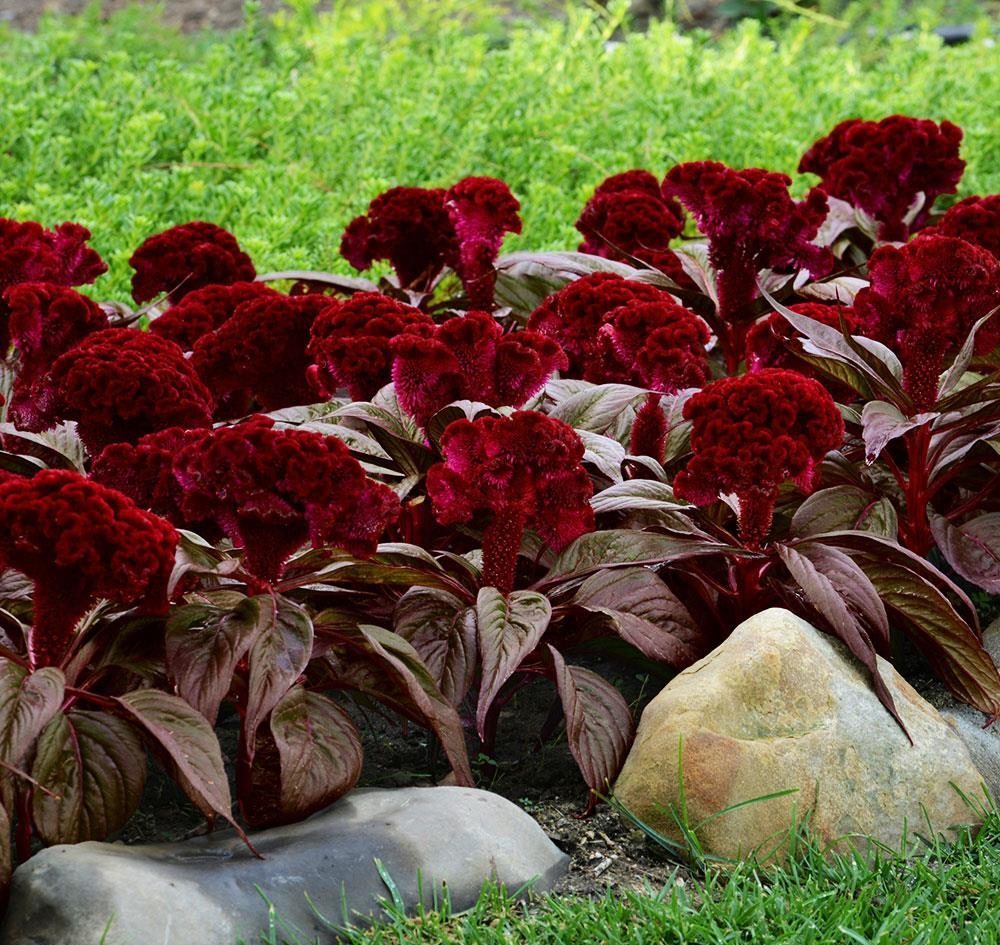
Dracula Celosia
Don’t be frightened: This Dracula isn’t dangerous. In fact, these plants are a lot of fun to have around! Dracula celosia is a novelty annual with large, unusually shaped flowers. The dark-purple flowers of this plant pair well with the purple-toned foliage, bringing eye-catching colour and drama to the summer garden. It’s one of the great landscaping bushes around.
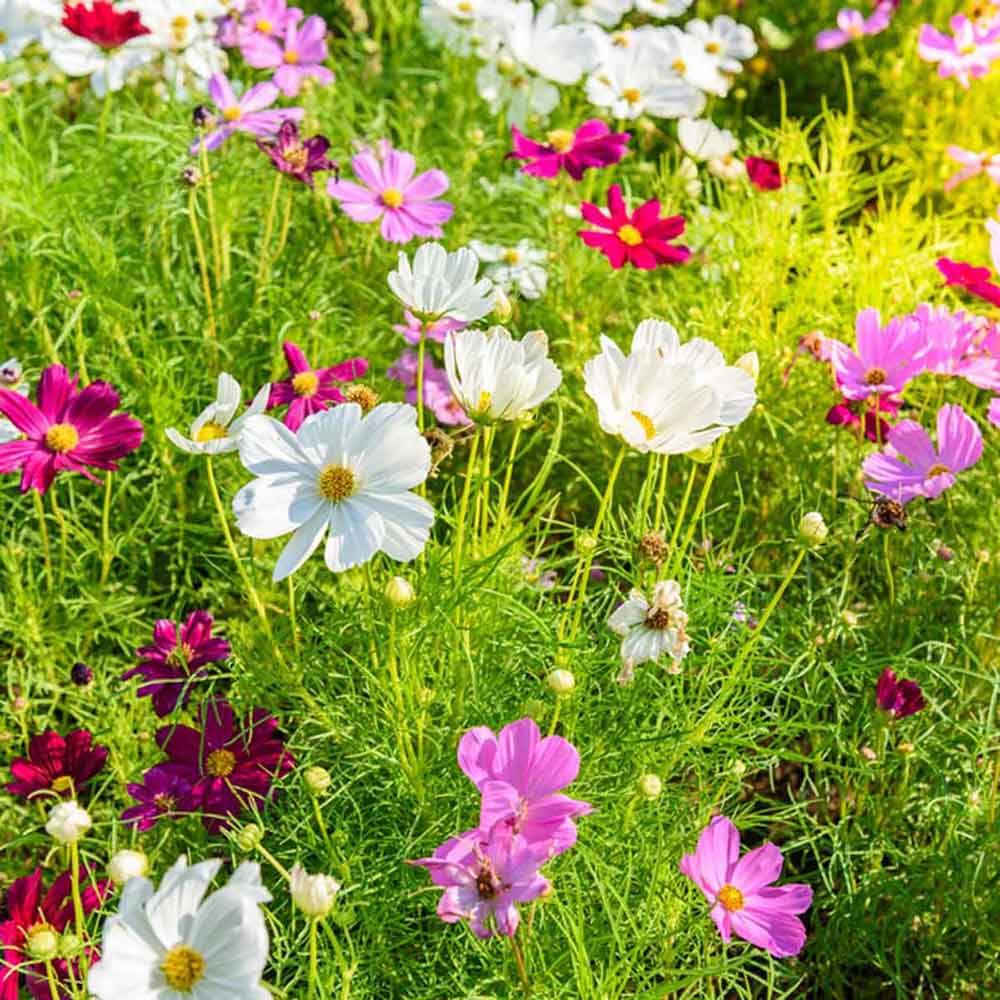
Cosmos
This pretty annual will grow almost anywhere. It has lacy foliage and also makes a good cut flower as one of the plants with colourful leaves.
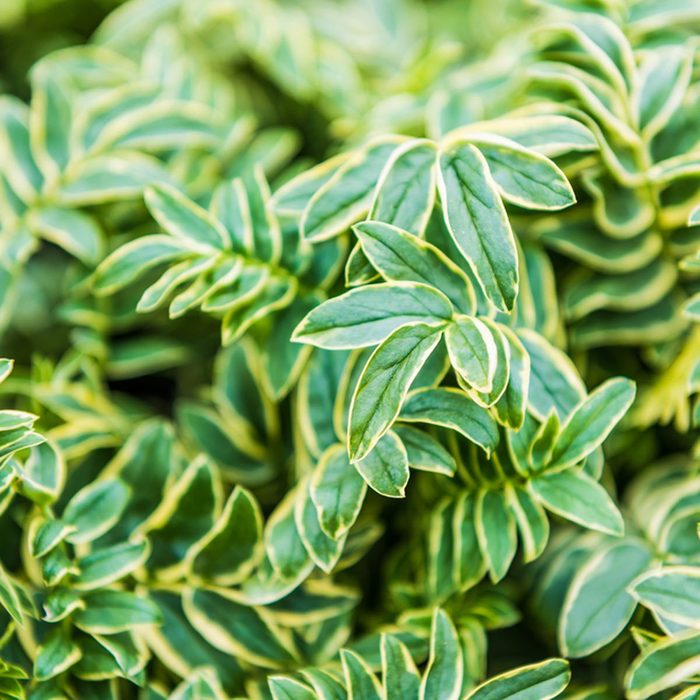
Jacob’s Ladder
Jacob’s ladder (Polemonium caeruleum) is a treat to have around when clear blue flowers appear in late spring and early summer. Even without the flowers, it earns a spot in the shade garden with its finely divided variegated leaves and is a good bet for landscape plant ideas. Jacob’s ladder looks particularly good in a natural setting with woody plants, ferns, rocks and tree stumps. It is hardy in Zones 4 to 8.
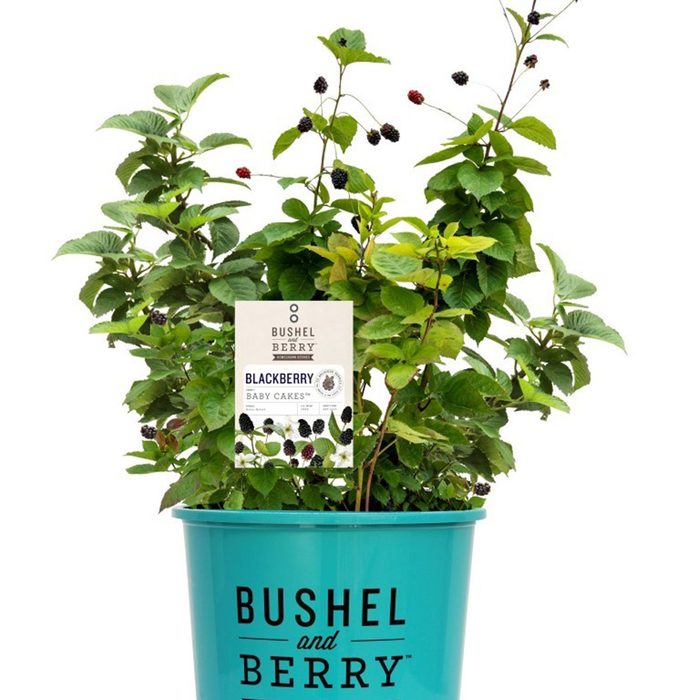
Baby Cakes Blackberry
Who wants to use blackberry in container gardening? They’re thorny and gangly! Well, Baby Cakes is a dwarf blackberry without thorns. Its compact habit (maturing at three to four ft. tall and wide) is perfect for patio pots. Baby Cakes offers up large, tasty blackberries in summer and may produce an encore crop later in the season in some climates. It is hardy in Zones 4-8. In cold climates, mulch or bury the pot for winter protection.
Check out these go-to herbs for every type of garden.
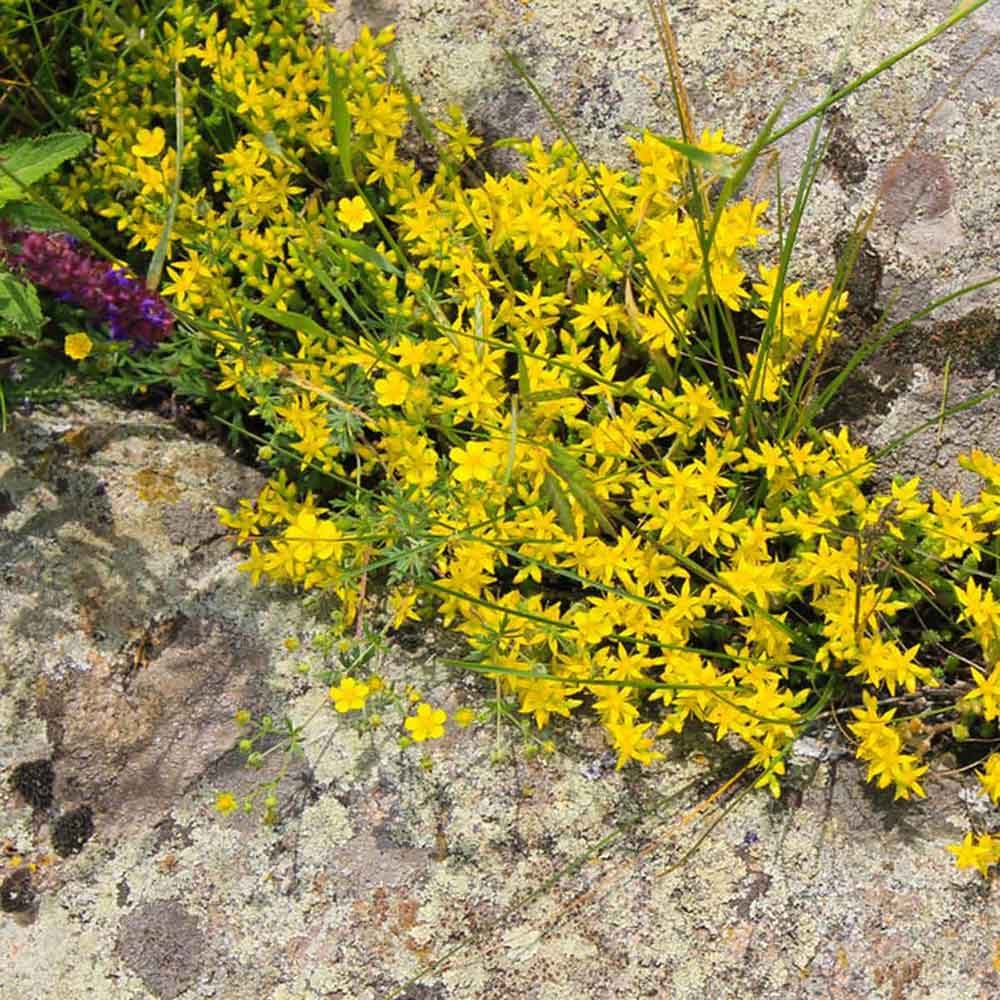
Sedum
Perennial sedum will grow almost anywhere and makes it one of the best landscape plant ideas. Some varieties grow as a groundcover, while others have an upright growth habit. Many sedums provide winter interest, as well.
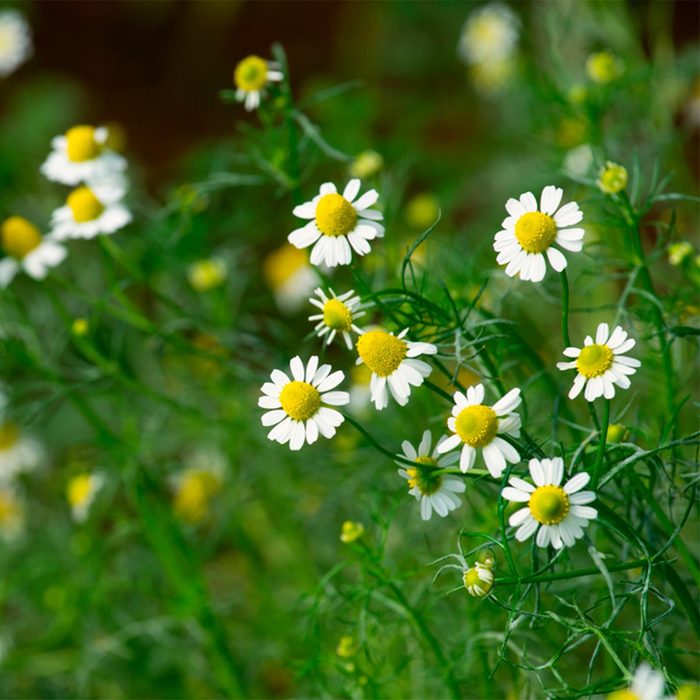
Chamomile
If you’re ready to relax, chamomile is the plant for you. Not only is the scent relaxing, but so is the tea made from chamomile (it’s often served to calm nerves and help with sleep). Roman chamomile (Chamaemelum nobile), Zones 4-9, is a shorter groundcover, while German chamomile (Matricaria recutita), Zones 2-8,is more upright. Both have daisy-like flowers in summer.
Interested in growing a healing garden? Consider adding these medicinal plants to your plot.
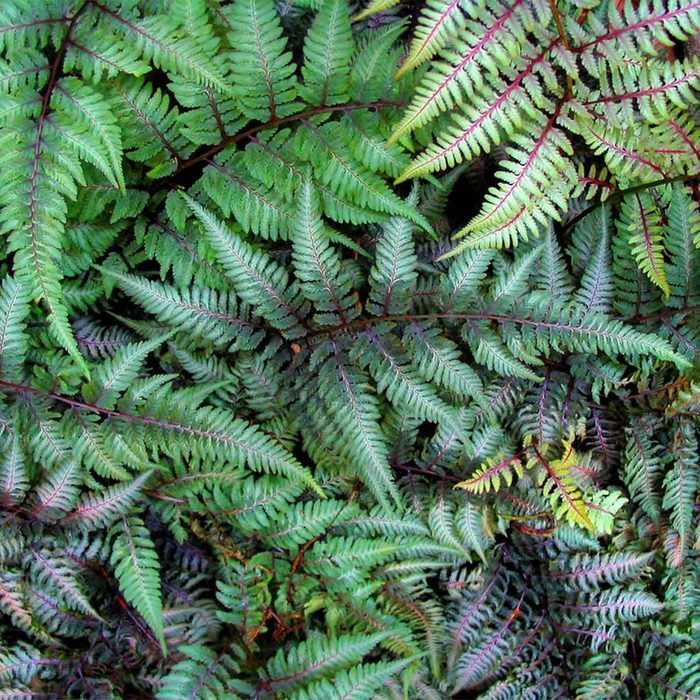
Japanese Painted Fern
Japanese painted fern (Athyrium filix-femina) is a small, well-behaved fern that makes a graceful addition to the shade garden. It won’t grow too big or too rambunctious, so it’s on the short list of best landscaping plants. Instead, it beckons you to take a closer inspection of its multicoloured foliage, which is an attractive mix of green, silver and maroon. Hardy in Zones 3 to 9, it grows two to three feet tall and wide.
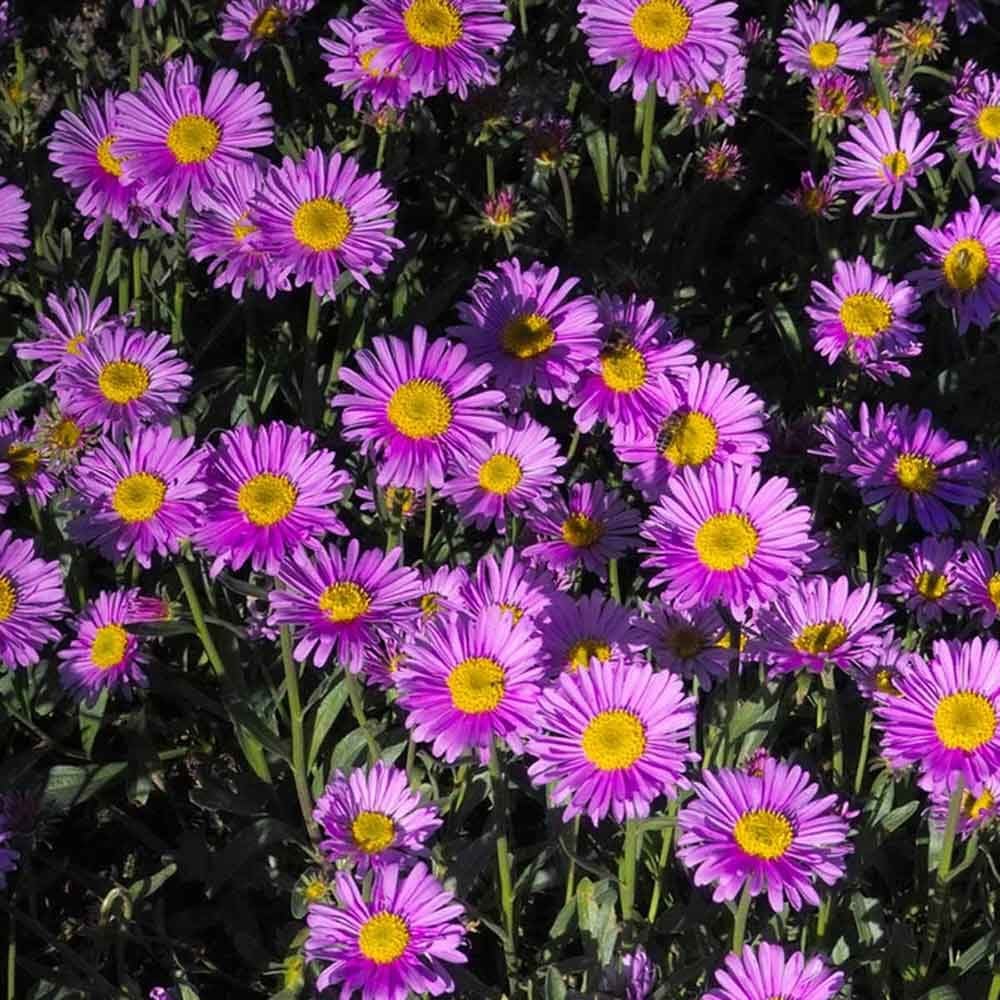
Asters
Asters are perennials that grow in full sun and provide bright colour in the fall. You’ll find pink, purple, blue and white plants that have a compact growth pattern.
Use these smart shed storage ideas to keep your garden tools organized.
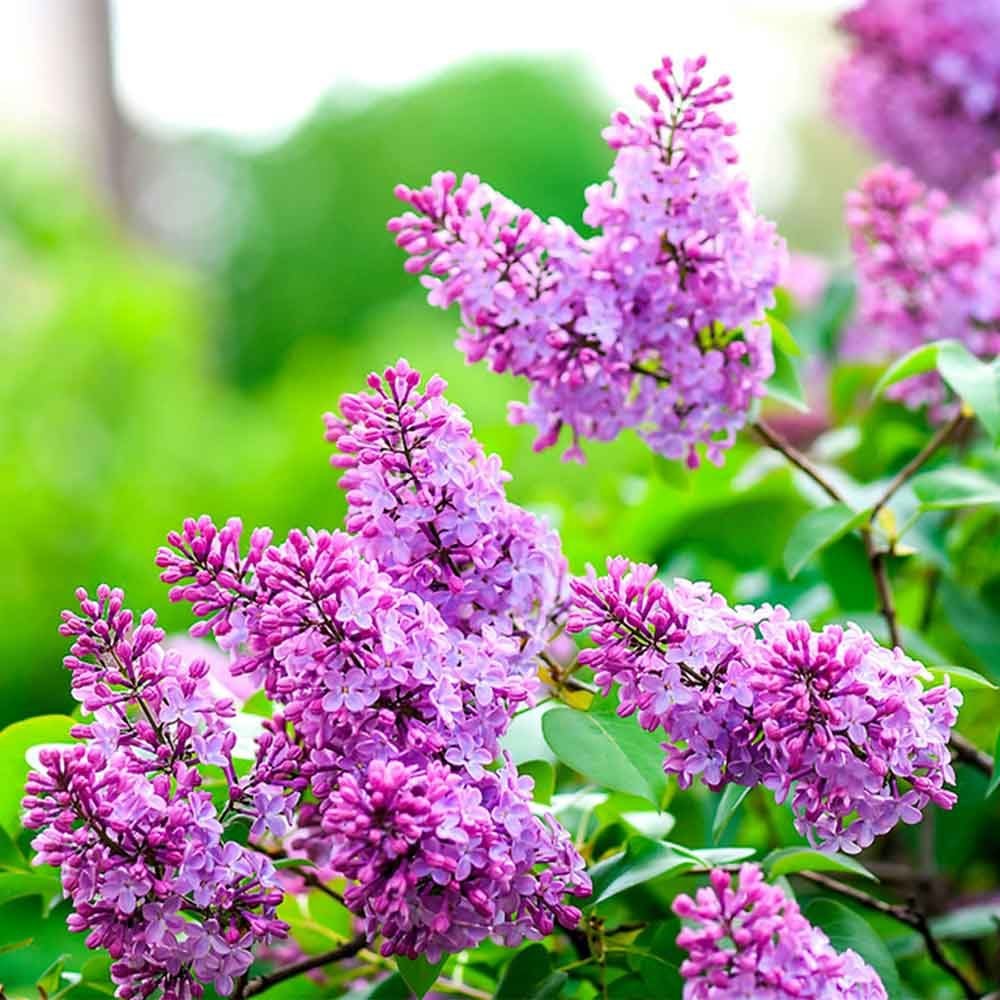
Lilacs
Beautiful, fragrant lilacs are always a good idea if you have the space—and it’s not hard to see why bees love them, they’re some of the best landscaping plants. Lilacs love well-drained soils and the sun, and they grow into large bushes over time.
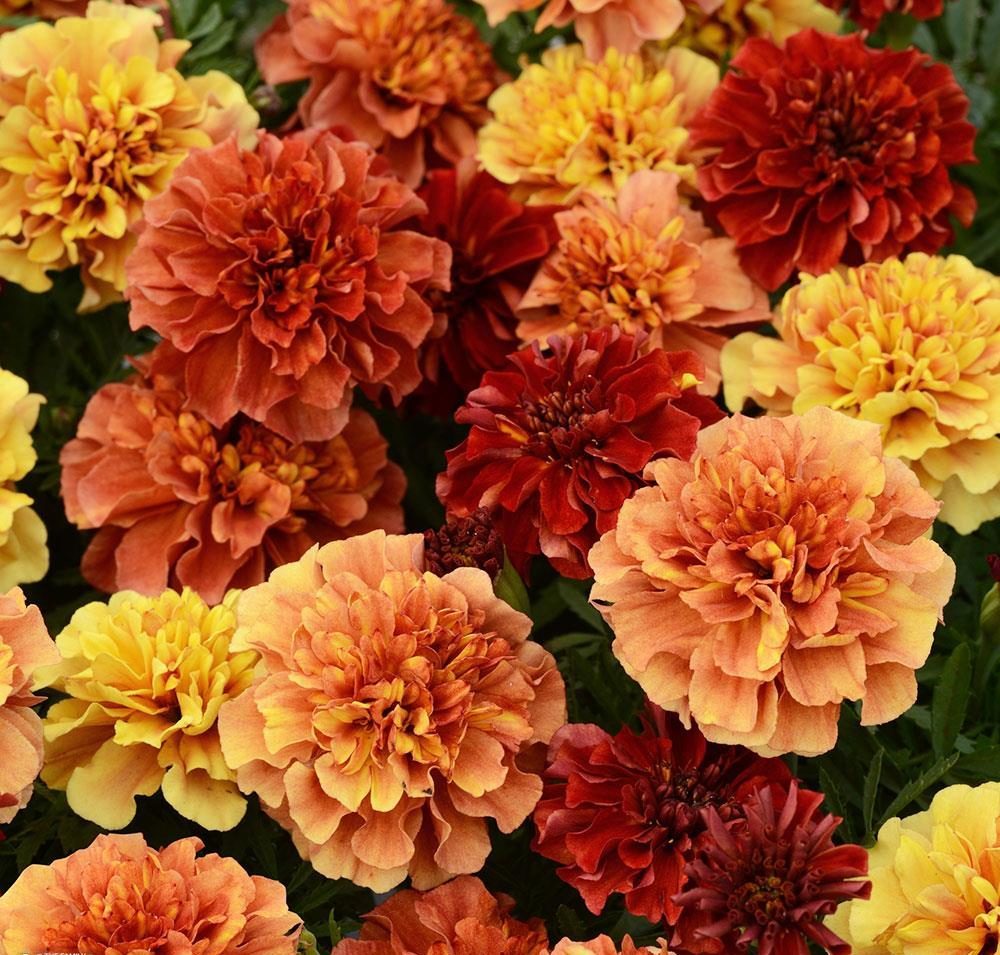
Strawberry Blonde French Marigold
This Strawberry Blonde will turn heads all right—just look at all the multicolour blooms on one plant! The flowers open deep pink with rustic yellow highlights, then mature to straw yellow. It’s a completely different look, yet the typical marigold qualities (mounded form, heat tolerance) are still readily apparent. Strawberry Blonde grows 8-10 in. tall and 6-8 in. wide, so it’s great in containers.
Don’t miss these tips for growing a vegetable garden—anywhere!
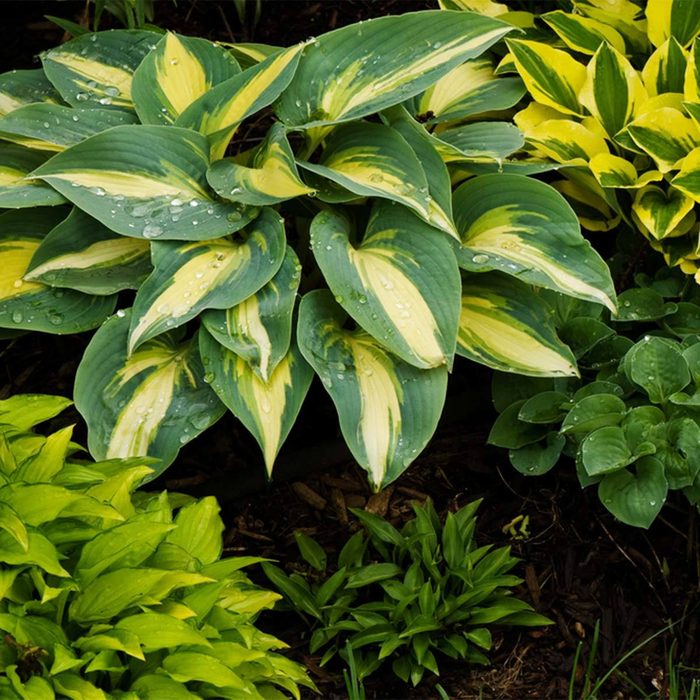
Hosta
A mainstay in shade gardens for decades, hosta still manages to attract new fans each year. And why not? The range of sizes, colours and variegations is staggering and makes hostas among the most popular landscape plant ideas. There is simply a hosta for everyone. No need to stick with the tried-and-true green varieties—not when there are chartreuse, blue and wildly variegated varieties at the ready. Some have small leaves, others large. All offer flowers in summer, but it’s the foliage that people love. Hosta is hardy in Zones 3 to 9.
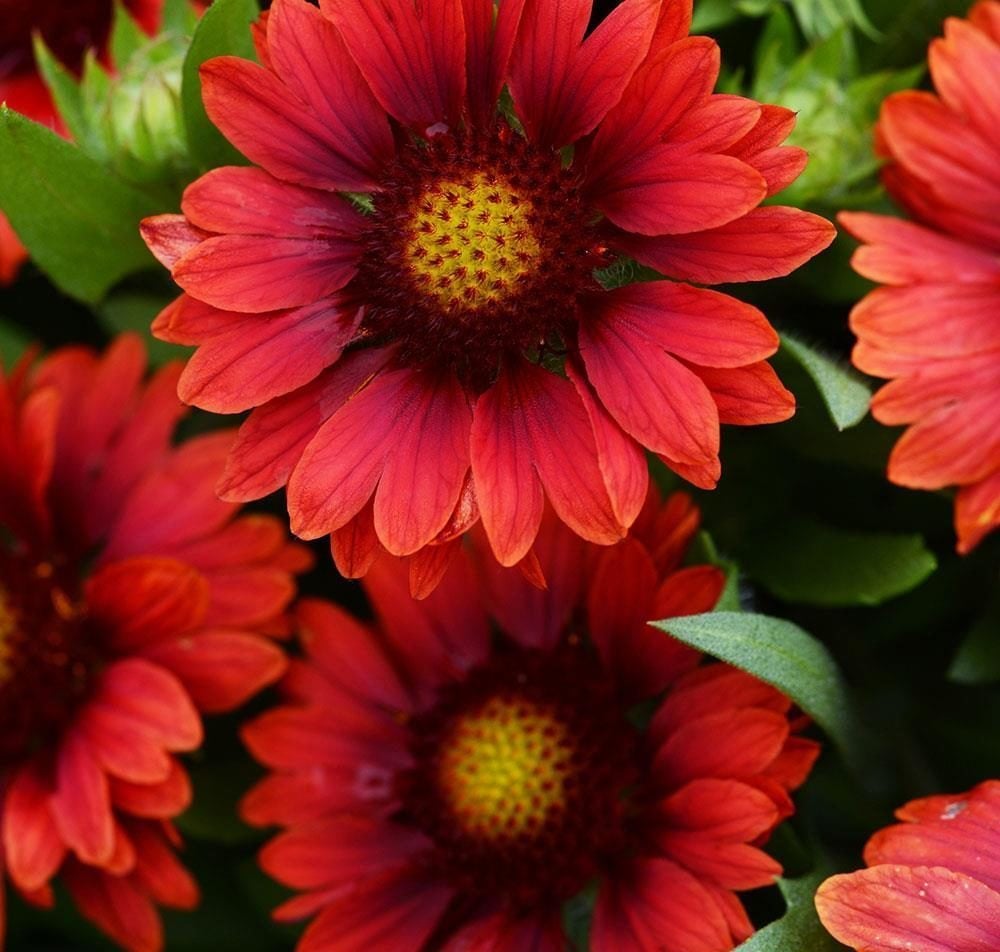
Mesa Red Gaillardia
For a different twist on a popular outdoor plant, try Mesa Red gaillardia. Its intense red colour won’t fade in the sun. This heat-tolerant perennial, sometimes grown as an annual, reaches 14-16 in. tall and 20-22 in. wide. It’s drought tolerant once established, and is great for pollinator gardens in particular. The Mesa series is also available in peach, yellow and bicolours if you’re looking for plants with colourful leaves.
Check out more simple landscaping ideas for the perfect garden.
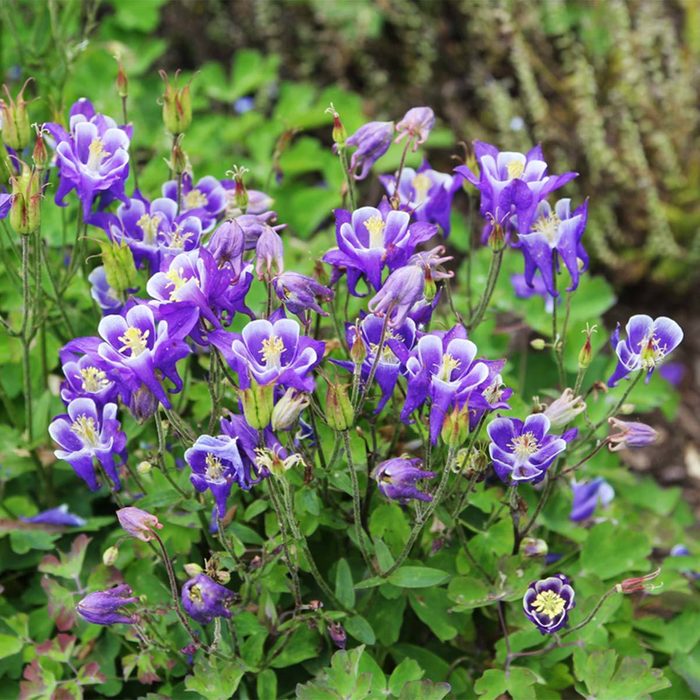
Columbine
The fern-like green to gray-green foliage tells you this is a shade plant, but the bright bi-coloured flowers look as if they belong in a sunny meadow. Indeed, columbine (Aquilegia) is an adaptable perennial that takes anything from full sun to shade. It seems to do best in part shade, where it can grab a few hours of sunlight each day. The intricate flowers come in a rainbow of colours and appear in late spring and early summer. Columbine is hardy in Zones 3 to 8 and is among the best garden flower plants.
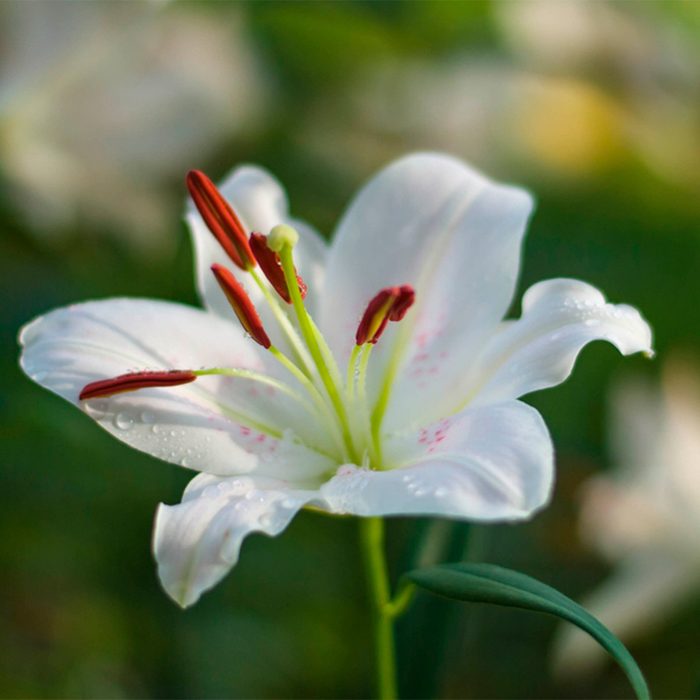
Lilies
With their elegantly shaped flowers, lilies make a wonderful addition to any garden. Add in the many bright colours, some of them two-tone, and the fact that many have an intoxicating scent as well, and you can see why lilies (Lilium spp.) are a beloved among garden flower plants and cut flower. They’re also simple to grow—if you can keep the rabbits away.
On the other hand, you should roll out the welcome mat for these insects that are good for your garden.
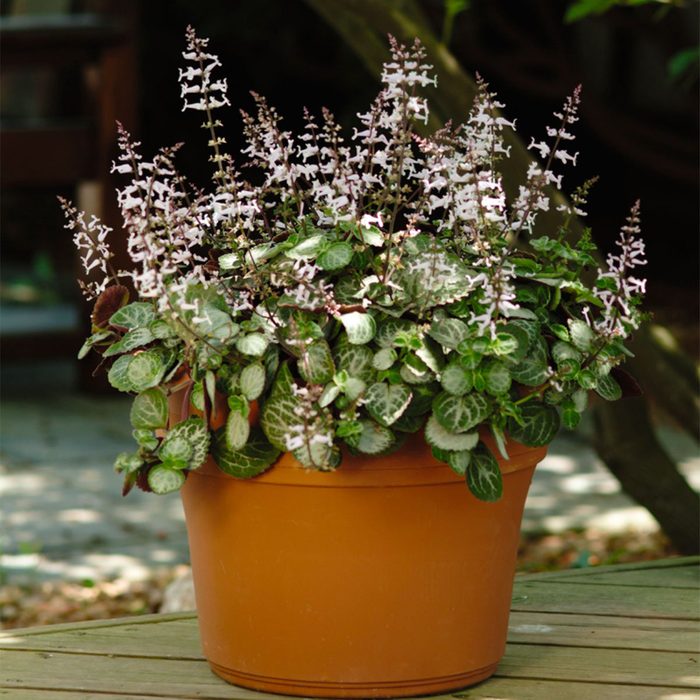
‘Emerald Lace’ Plectranthus
This drought-tolerant tropical is better known as a houseplant, but it can be used in outdoor container gardening, too. Let it vacation outdoors in summer in a shady spot by itself or with companions. The textured, variegated leaves are silver-gray and green, providing eye appeal all on their own. But they’re topped by delicate white flowers in late summer.
No budget for new planter pots? No problem! Take inspiration from these thrifty repurposed garden containers.
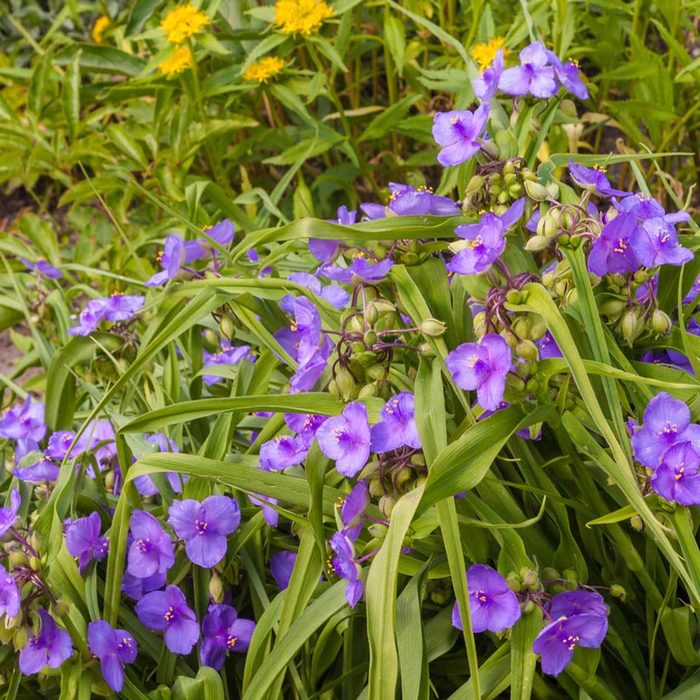
Spiderwort
Spiderwort’s narrow, grasslike foliage is a nice complement to hosta’s traditional wide-leaf look. And while it may not have the variegation choices of hosta, it does have some pretty fine-looking blue-purple flowers from midsummer to fall. Spiderwort (Tradescantia) is also tough, needing no help to grow or protection from deer. If anything, it can become a bit thuggish if left to its own devices. Best to divide plants occasionally to make room for other landscaping plants. Or plant it in a shade garden where it can’t take over. Spiderwort is hardy in Zones 4 to 11 and one of the plants with colourful leaves you can add.
These clever yard tool hacks will make your outdoor chores a whole lot easier this season.
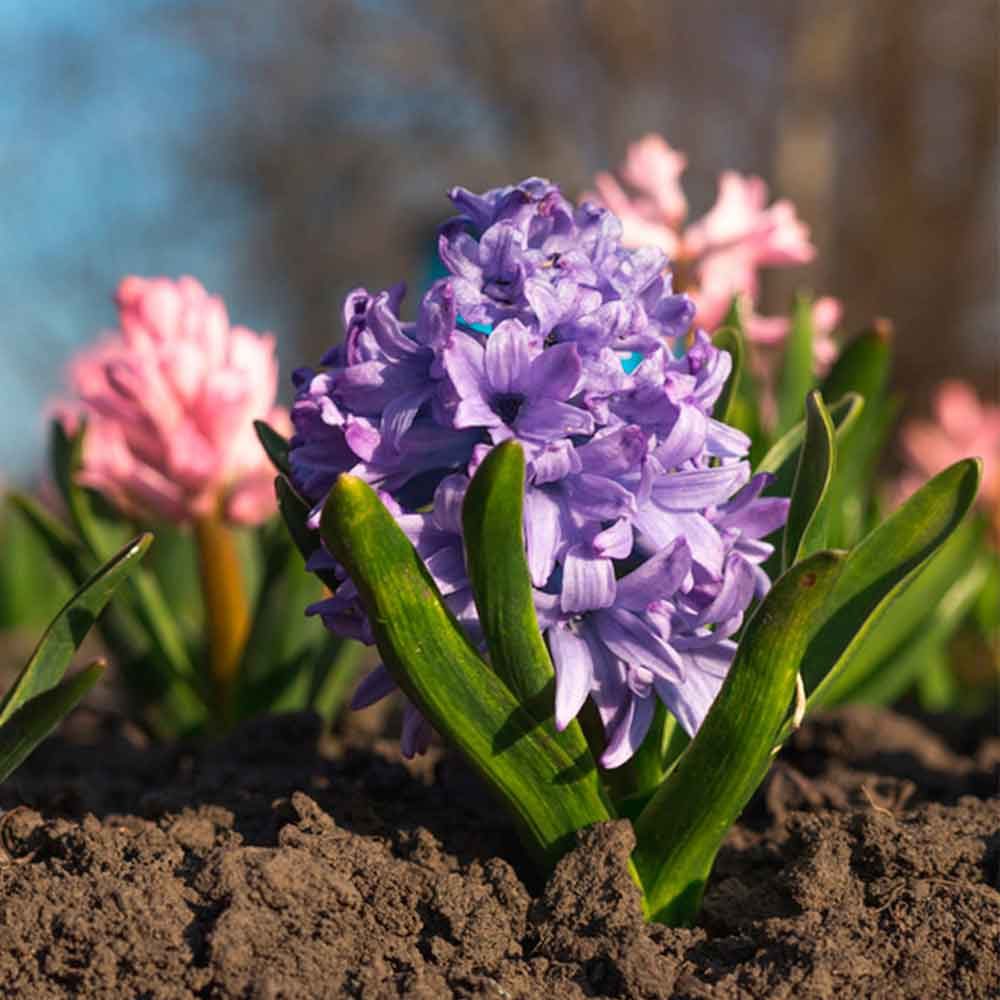
Hyacinth
Looking for something a little more bold and beautiful? Hyacinth is popular among bee species and is a great way to build up a flower bed worthy of showing off. Additionally, hyacinth plants are quite adaptable in terms of where they can grow, as long as the soil is well-drained. Plant these bulbs in autumn for best results.
Working with a tiny yard? These urban gardening tips are perfect for small spaces.
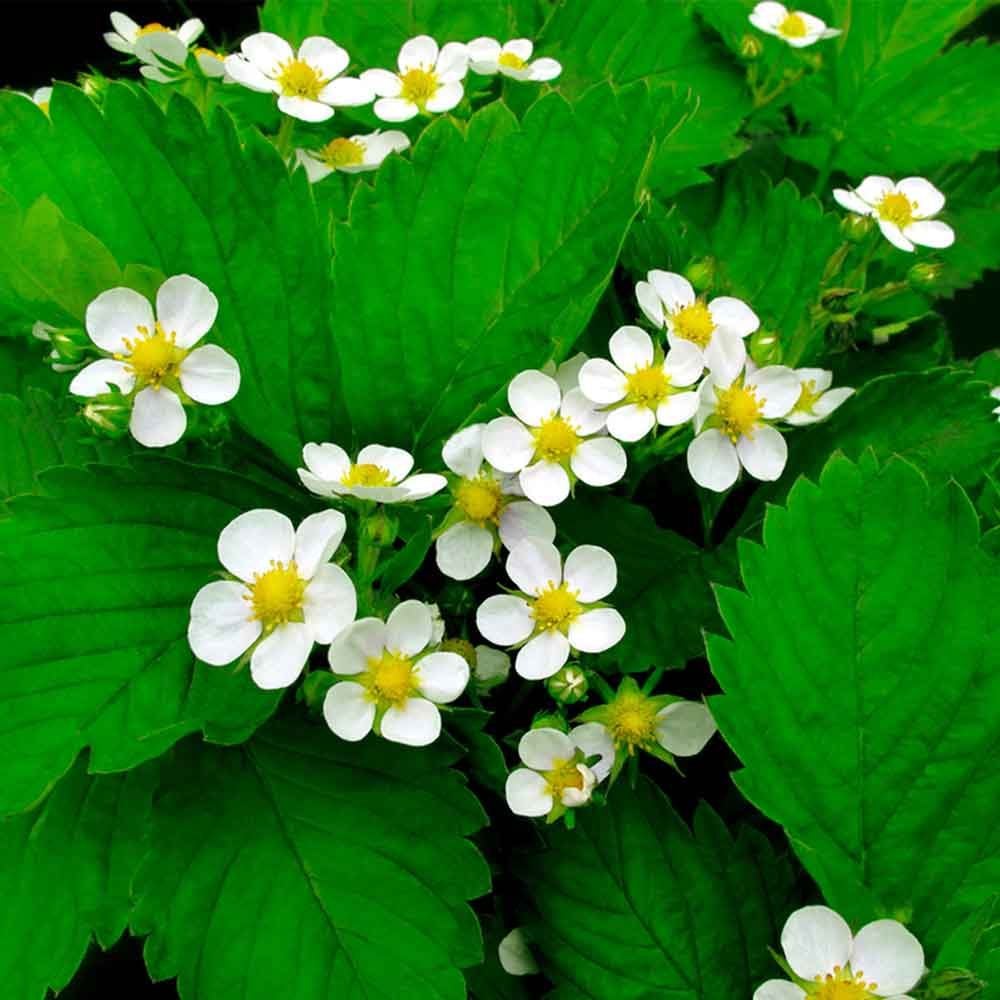
Berries
Blueberries, strawberries, raspberries…if you like growing berries in your yard, keep in mind that as long as they flower, the bees will like them, too. Note that not all varieties of berries will produce edible berries, especially in the first year of growth, so plan appropriately if you have your eye on the food aspect.
Here are more bee-friendly plants worth adding to your yard, garden or balcony.
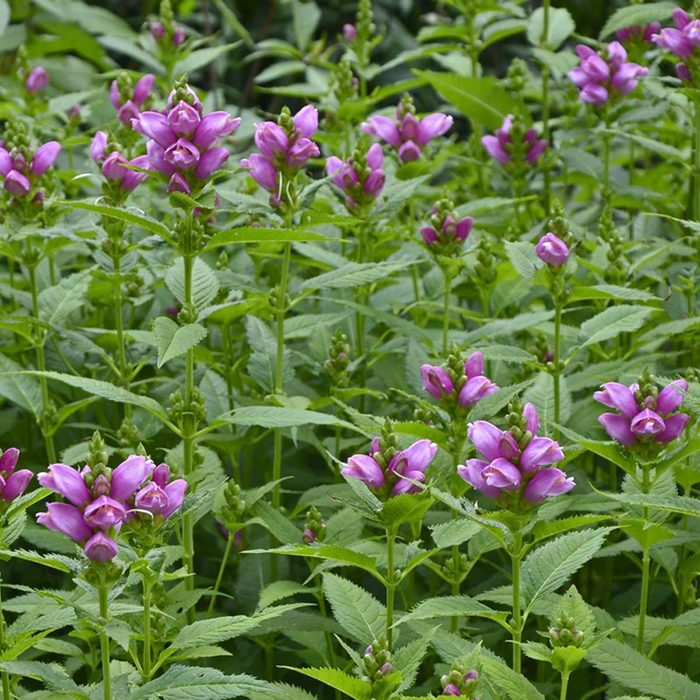
Turtlehead
Turtlehead (Chelone) has hooded flowers in hues of red, rose, pink and violet from late summer to fall—a fine time to welcome newly arriving flowers to the shade garden. It prefers moist soils and will take anything from full sun to shade. Part shade seems to suit it best. Turtlehead is hardy in Zones 3 to 8 and one of the easier plants with colourful leaves to add.
Psst—professional landscapers say you should never plant these flowers in your garden.
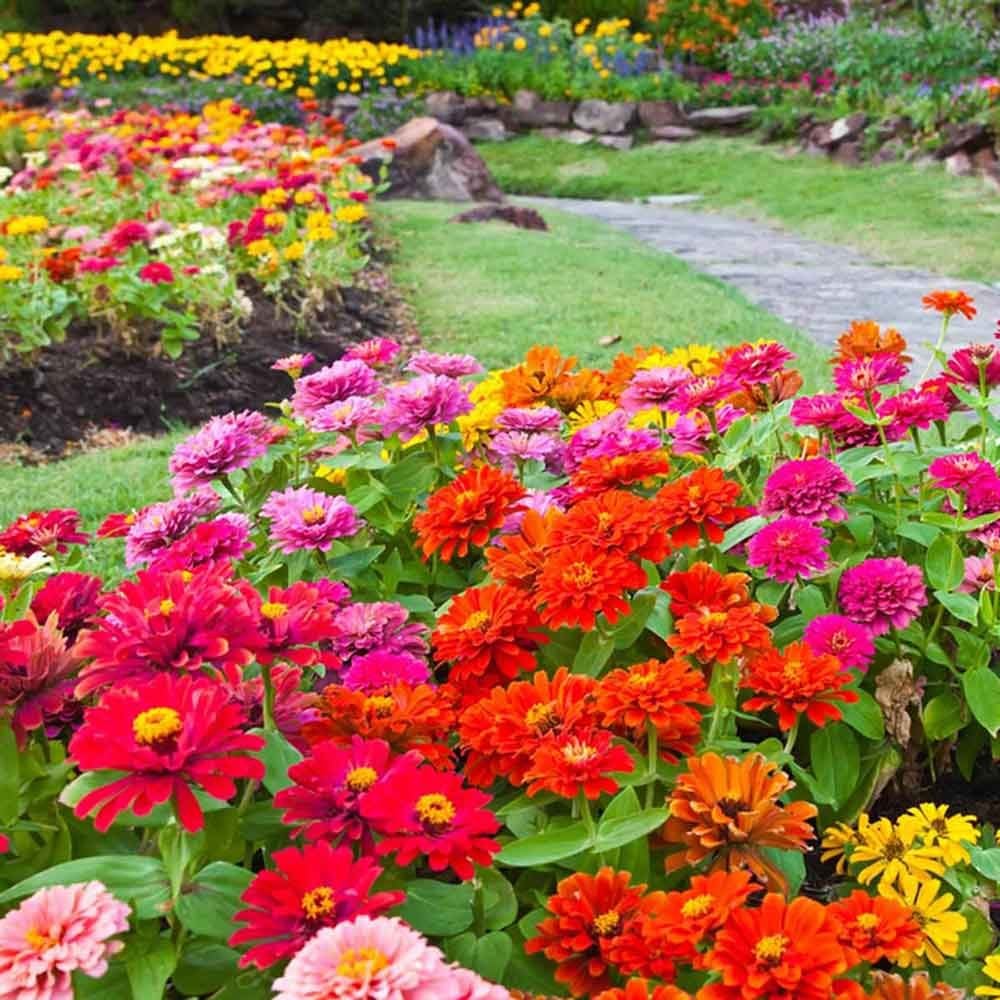
Zinnia
Easy to grow, tenacious, and vibrantly coloured, these annuals are also long bloomers and gorgeous cut flowers. They’re garden flower plants that everyone loves.
Now that you’re inspired by these colourful plants, use these genius gardening tips to grow your own!